
- •Preface
- •Content
- •Tissues
- •Nerve Tissue
- •Skin - Epidermis
- •Skin - Dermis
- •Skin - Glands
- •Subcutaneous Layer
- •Skeleton
- •Axial Skeleton
- •Cranium
- •Cranial Bones – Inferior Nasal Concha
- •Vertebral Column
- •Sacrum and Coccyx
- •Ribs
- •Sternum
- •Clavicle
- •Scapula
- •Humerus
- •Ulna
- •Radius
- •Metacarpals and Phalanges
- •Pelvis - Male
- •Femur
- •Tibia
- •Fibula
- •Tarsal Bones - Cuboid and Navicular
- •Phalanges
- •Patella
- •Skeletal Muscles
- •Transversospinales Muscles
- •Cervical Hypaxial Muscles
- •Thoracic and Abdominal Hypaxial Muscles
- •Shoulder Muscles - Rotator Cuff
- •Shoulder Muscles - Prime Movers
- •Anterior Brachial Muscles
- •Posterior Brachial Muscles
- •Posterior Thigh Muscles
- •Thigh Muscles
- •Lateral Leg Muscles
- •Posterior Leg Muscles
- •Spinal Nerves
- •Dorsal Rami
- •Intercostal Nerves
- •Cutaneous Nerves
- •Autonomic Nerves
- •Spinal Cord
- •Brain
- •Cerebrum
- •Cerebellum
- •Meninges
- •Hypothalamus
- •Pituitary Gland
- •Pineal Gland
- •Thymus
- •Pancreas
- •Ovaries
- •Testes
- •Blood
- •Heart
- •Lymphatics
- •Larynx
- •Lungs
- •Cast of Trachea and Bronchial Tree
- •Esophagus
- •Stomach
- •Pancreas
- •Large Intestine
- •Mesenteries
- •Omenta
- •Female Reproductive Organs
- •Ovary
- •Vagina
- •Ductus Deferens and Spermatic Cord
- •Penis
- •Index
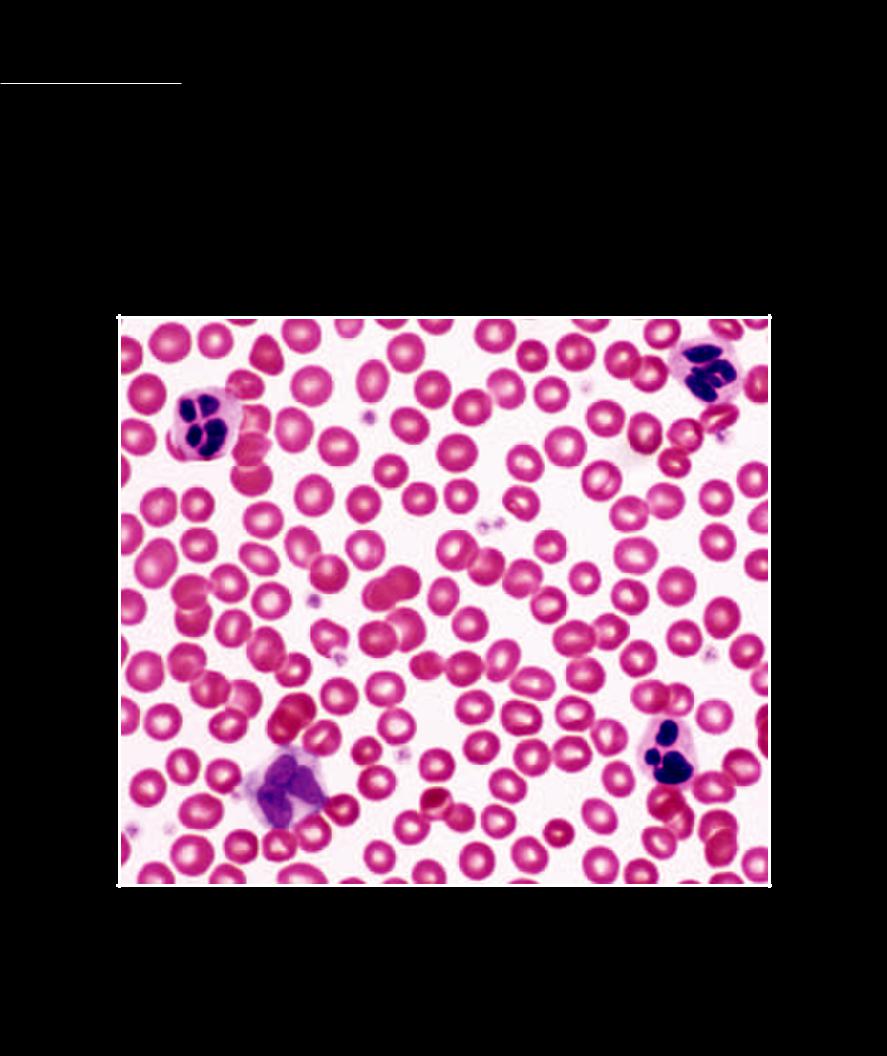
Blood In the histology chapter we learned that the fl uid material we call blood has been historically classifi ed as a connective tissue. This classifi cation was a result of the fact that, like other connective tissues, blood
has more extracellular matrix than cells. More recently, however, blood has been placed in a tissue category of its own — the hematolymphoid complex. The extracellular portion of the blood is a water solution that gives rise to its liquid nature. Blood is closely related to other aqueous fl uids within the body, in fact most of the other body fl uids, such as interstitial fl uid, lymph, cerebrospinal fl uid, and aqueous humor, arise from the blood. These extracellular fl uids are the water environment that nourish, protect, and exchange with every cell of the body. This water environment is derived from the blood, renewed by the blood, and returned to the blood. Dispersed in the blood plasma are the three groups of blood cells — erythrocytes (red blood cells), leukocytes (white blood cells), and thrombocytes (platelets). The blood smear below depicts the three cell categories.
1 Erythrocyte (red blood cell)
2 Leukocyte - neutrophil (white blood cell)
3 Leukocyte - monocyte (white blood cell)
4 Thrombocyte (platelet)
5 Blood plasma
1
2
4
2
1
5
4
1
4
1 |
1 |
1
5
4 |
2 |
3
Blood smear
700x
262
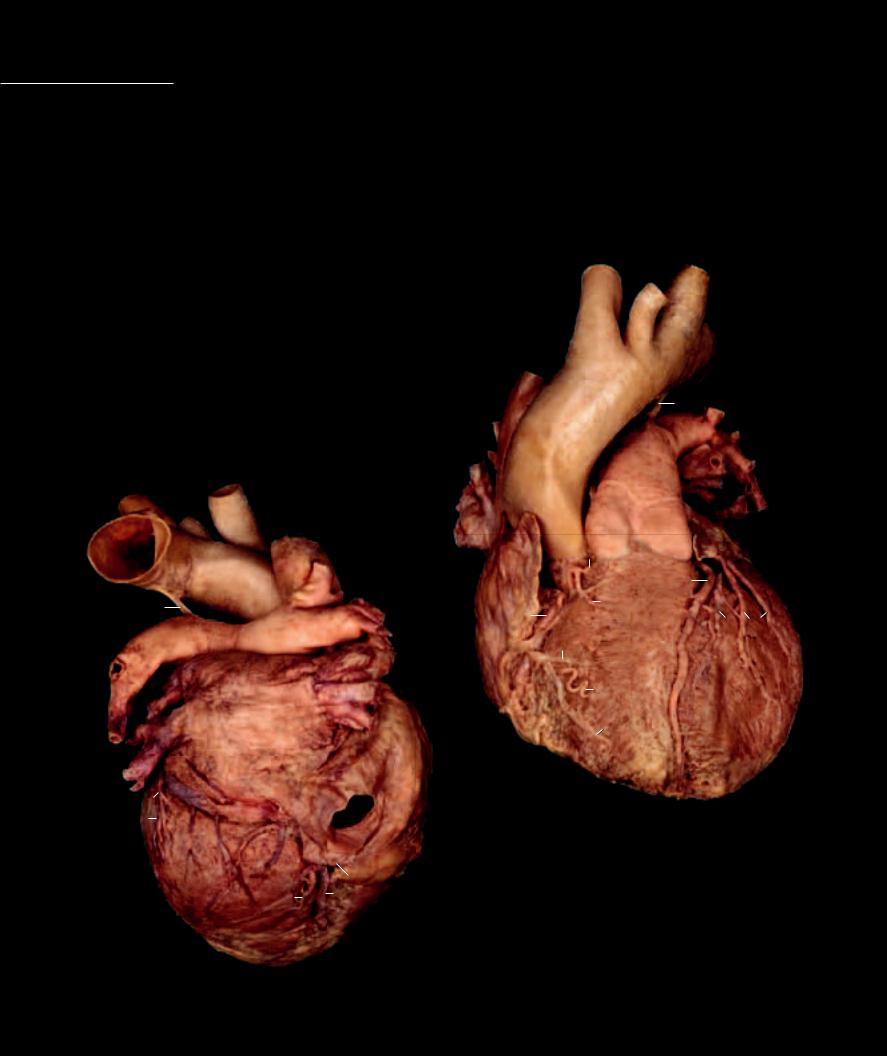
Heart From its origin in the embryo as a simple pumping tube, the heart develops into a strong fi bromuscular organ. During its development the original tubular pump is folded and subdivided into a four chambered organ that has a pyramidal or conical form. It is approximately the size of a closed fi st and weighs
approximately 300 grams in males and a little less than this in females. For its small size, comprising only one half of one percent of the total body mass, it is an important and functionally amazing organ. The wall of the heart consists of three structural layers that each play significant roles in its function as an effi cient pump. While the tissue makeup of this wall is similar at any location in the heart, the thickness can vary considerably. Internally a septum and series of valves divide the heart into four chambers through which the blood moves in a unidirectional flow. The chambers differ in structure and function, which is primarily reflected in the anatomy of their walls. Embedded within the walls of heart is a special electrical conduction system that helps regulate its coordinated pumping action.
1 |
Right atrium |
18 |
Right coronary artery |
|
|
|
|
2 |
Left atrium |
19 |
Conus arteriosus branch |
|
|
|
|
3 |
Right ventricle |
20 |
Marginal branch |
|
|
|
|
4 |
Left ventricle |
21 |
Anterior interventricular artery |
|
|
|
|
5 |
Right auricle |
22 |
Lateral branches |
|
10 |
||
6 |
Left auricle |
23 |
Circumflex branch |
8 |
9 |
|
|
7 |
Aorta |
24 |
Posterior interventricular artery |
|
|
||
8 |
Brachiocephalic artery |
25 |
Anterior cardiac vein |
|
|
|
|
9 |
Left common carotid artery |
26 |
Great cardiac vein |
|
|
|
|
10 |
Left subclavian artery |
27 |
Posterior vein of left ventricle |
|
|
|
|
11 |
Pulmonary trunk |
28 |
Middle cardiac vein |
|
|
|
|
12 |
Right pulmonary artery |
29 |
Small cardiac vein |
15 |
|
|
|
13 |
Left pulmonary artery |
30 |
Right superior pulmonary vein |
|
|
|
14 |
|
|
||||||
14 |
Ligamentum arteriosum |
31 |
Right inferior pulmonary vein |
|
|
|
|
15 |
Superior vena cava |
32 |
Left superior pulmonary vein |
|
13 |
||
16 |
Inferior vena cava |
33 |
Left inferior pulmonary vein |
|
|
|
|
17 Coronary sinus |
|
|
|
|
7 |
|
|
|
|
|
|
|
|
|
|
|
|
||||
|
|
|
|
|
|
|
|
|
|
|
|
11 |
32 |
|
|
||||||
10 |
|
|
|
|
|
|
|
|
|
|
|
|
|
|
|
|
|
33 |
|
||
|
|
|
|
|
8 |
|
|
|
|
|
|
|
|
|
|
|
|
|
|||
9 |
|
|
|
|
|
|
|
|
|
|
|
|
|
|
|
|
|||||
|
31 |
|
|
|
|
|
|
|
|
|
|
|
|
|
|
|
|||||
|
|
|
|
|
|
|
|
|
|
|
|
|
|
|
|
|
|
|
|
|
|
|
|
|
|
|
|
15 |
5 |
|
|
|
19 |
|
6 |
|
|||||||
14 |
|
|
7 |
|
|
|
|
|
|
|
|
|
|
20 |
21 |
|
|
|
|||
|
|
1 |
18 |
|
|
|
|
|
|
|
|
|
|
|
|
||||||
|
|
|
|
|
|
|
|
|
|
|
|
|
|
||||||||
|
|
|
|
|
|
|
|
|
|
|
|
|
|
||||||||
|
|
|
|
|
|
|
|
|
|
|
|
26 |
22 |
||||||||
|
|
|
|
|
|
|
|
|
|||||||||||||
|
|
|
|
|
|
|
|
|
|
|
|
|
|||||||||
|
|
|
|
|
|
|
|
|
|
|
|
|
|
|
|
||||||
|
|
|
|
|
|
|
|
|
|
|
|
|
|
|
|
||||||
|
|
|
|
|
|
12 |
|
|
|
|
|
3 |
|
|
|
||||||
13 |
|
|
|
|
|
|
25 |
|
|
|
|
|
|
|
|||||||
|
|
|
|
|
|
|
|
|
|
|
|
|
|
|
|
||||||
|
|
|
30 |
|
|
|
|
|
|
|
|
|
|
|
|
|
|
|
|||
|
|
|
|
|
|
|
|
|
|
|
|
|
|
|
|
|
|
|
|
|
|
|
|
|
|
|
|
|
|
|
|
|
|
|
|
|
|
|
|
|
|
|
|
32 |
|
|
|
|
|
|
|
|
|
|
|
20 |
|
|
|
|
|||||
|
|
|
|
|
|
31 |
|
|
|
|
|
|
|
|
|
|
|
4 |
|||
|
|
|
|
|
|
|
|
|
|
|
|
|
|
|
|
|
|
|
|
||
33 |
|
2 |
|
|
|
|
|
25 |
|
|
|
|
|||||||||
|
|
|
|
|
|
|
|
|
|
|
|||||||||||
|
|
|
|
|
|
1 |
|
|
|
|
|
|
|
|
|
|
|
|
|
|
|
235 |
|
|
|
17 |
16 |
|
|
|
|
|
|
|
|
|
|
|
|
|
|
|
|
27 |
|
|
|
|
|
|
|
|
|
|
|
|
|
|
Heart |
|
|
|
|
||
|
|
|
|
|
|
|
|
|
|
|
|
|
|
|
|
|
|
||||
|
|
|
|
|
|
|
|
|
|
|
|
|
|
|
|
|
|
|
|
||
|
|
|
|
|
Anterior view |
4 |
|
29 |
|||
24 |
|
|
|
28 |
|
|
|
|
|
||
|
3 |
||||
|
|
||||
Heart
Posterior view
263

Heart
1 |
Parietal pericardium |
|
26 |
|
|
||
|
|
|
|
|
|
||
2 |
Fibrous pericardium |
|
|
|
|
|
|
3 |
Visceral pericardium |
|
|
|
|
|
|
4 |
Epicardium |
|
|
|
|
|
|
5 |
Myocardium |
|
30 |
3 |
|
||
6 |
Endocardium |
|
2 |
||||
|
|
|
|
|
|||
7 |
Right atrium |
|
|
|
|
|
1 |
8 |
Right auricle |
|
|
|
|
|
|
9 |
Interatrial septum |
41 |
8 |
|
|
||
10 |
Fossa ovalis |
|
|
|
|
|
|
11 |
Crista terminalis |
|
|
|
13 |
|
|
|
|
|
|
||||
12 |
Valve of inferior vena cava |
|
11 |
|
|
||
13 |
Pectinate muscle |
|
9 |
|
|
||
14 |
Tricuspid valve |
|
|
|
|||
15 |
Chordae tendineae |
|
10 |
|
16 |
||
|
|
|
|
14 |
|||
16 |
Trabeculae carnae |
|
|
|
|
|
|
17 |
Papillary muscle |
|
|
|
|
|
23 |
18 |
Right ventricle |
|
12 |
15 |
|
||
19 |
Pulmonary valve |
|
17 |
||||
|
|
|
|
|
|||
20Left atrium
21Left auricle
22Bicuspid valve
23Left ventricle
24 Aortic valve |
40 |
25Apex
26Aorta
27Brachiocephalic artery
28 |
Left common carotid artery |
Dissection of heart and pericardial sac |
29 |
Left subclavian artery |
Anterolateral view |
30 |
Pulmonary trunk |
|
31 |
Left pulmonary artery |
|
32 |
Ligamentum arteriosum |
35 |
33 |
Anterior interventricular artery |
34Lateral branches of interventricular artery
35Superior vena cava
36Right coronary artery
37Left coronary artery
38 |
Right pulmonary veins |
26 |
39 |
Left pulmonary veins |
|
40 |
Diaphragm |
38 |
41 |
Lung |
|
13 8
|
|
|
16 |
|
|
|
|
|
7 |
|
|
|
|
|
|
|
|
|
|
6 |
|
|
|
|
|
|
4 |
|
36 |
|
|
|
|
|
|
|
|||
|
|
|
|
|
|
|
|||
|
|
|
|
|
|
|
|
|
|
|
|
|
|
|
|
|
|
5 |
15 |
|
|
|
|
|
|
|
|
14 |
|
|
|
|
|
|
|
|
|
|
|
|
18 |
|
23 |
|
|
|
|
17 |
|
|
|
|
|
|
|
|
|||
|
|
|
|
|
|
|
|
|
|
|
|
|
|
|
|
|
|
|
15 |
29
27 28
|
|
32 |
|
|
|
||
|
31 |
|
|
30 |
|
|
|
|
39 |
||
19 |
21 |
|
|
|
|||
|
|||
33 |
|
|
34 |
|
|
|
|
|
|
|
|
|
|
|
23
16
25
Transverse section of heart comparing ventricle thickness |
Dissected heart showing interior of chambers |
Inferior view, left ventricle at right |
Anterior view |
264
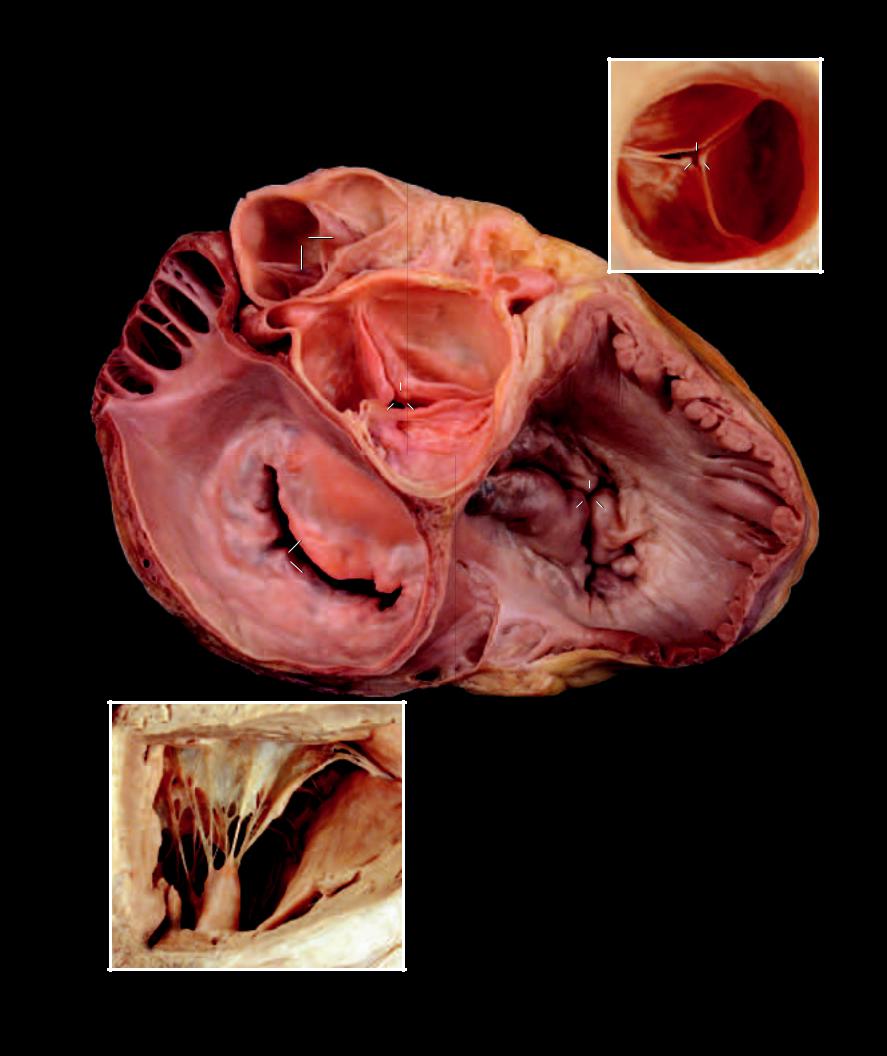
24
19
36 |
Aortic valve |
|
|
|
Superior view |
13 37
24
13
20 |
14 |
7
9
22
Heart dissection with atria and arteries removed
Superior view, anterior at top
14
15
18
16
17
Dissection of heart revealing tricuspid valve
Anterior view
265
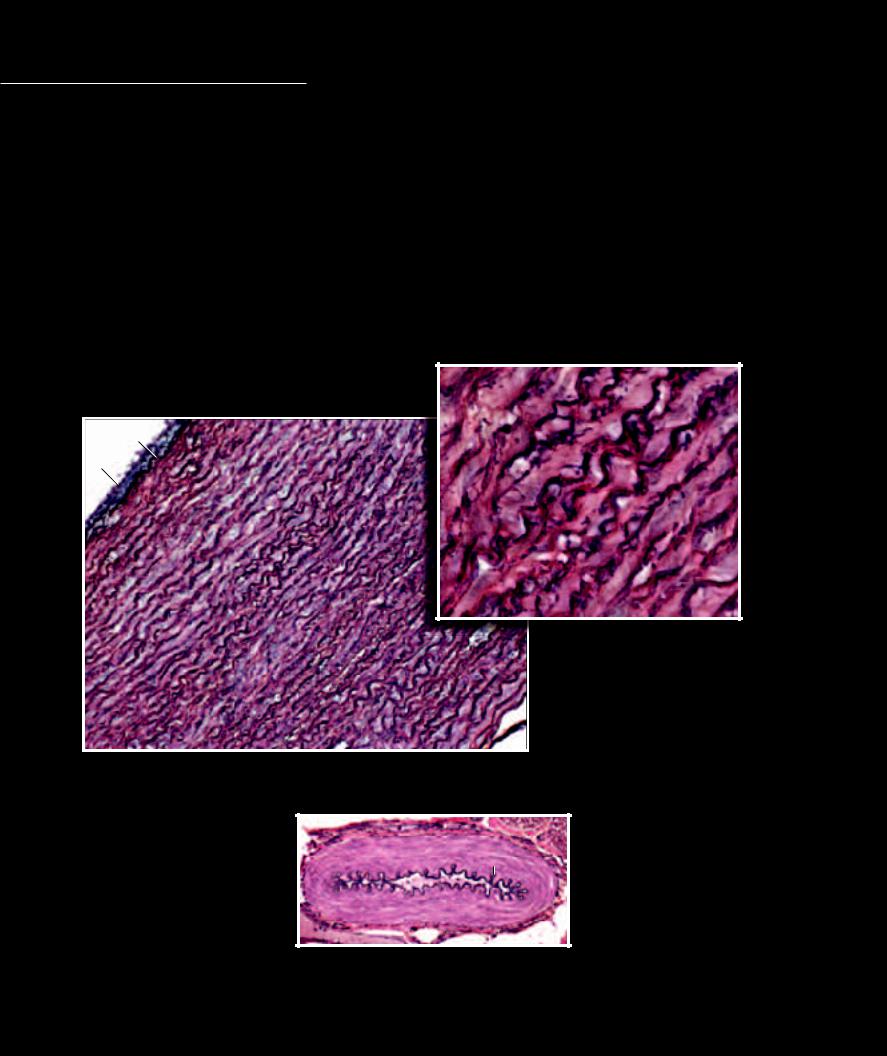
Like all tubes in the body, blood vessels have a basic pattern of design that involves three structural tunics, or layers. The inner layer of the vessel is the tunica intima. This consists of the luminal endothelium and a thin network of underlying elastic
connective tissue. The middle layer of the vessel is the tunica media, which consists of varying amounts of smooth muscle and elastic connective tissue. Variations in the tunica media defi ne the different types of blood vessels. The outer layer, the tunica externa, is a dense connective tissue outer coat. The designations — elastic arteries, muscular arteries, arterioles, venules, and veins — are based on size differences and the differences in the vessels’ tunica media. Elastic arteries have a thick elastic tunica media. Muscular arteries have a tunica media dominated by smooth muscle. Arterioles are tiny arteries with a muscular tunica media. All the venous vessels have a thin, almost non-existent tunica media. The smallest blood vessels, the capillaries, loose all the layers of their wall except the inner endothelium. These microscopic, thin walled tubes become the exchange vessels of the system.
1 |
Endothelium of tunica intima |
6 |
Red blood cells |
2 |
Internal elastic membrane of tunica intima |
7 |
White blood cells |
3 |
Elastic lamellae of tunica media |
8 |
Venous valves |
4 |
Smooth muscle cells of tunica media |
9 |
Nerve |
5 |
Connective tissue of tunica externa |
10 |
Striated skeletal muscle |
3
2
1 |
3 |
|
3
3
3
Elastic lamellae of aorta
640x
Section of aorta — large elastic artery
100x
5
42
Muscular artery
100x
266
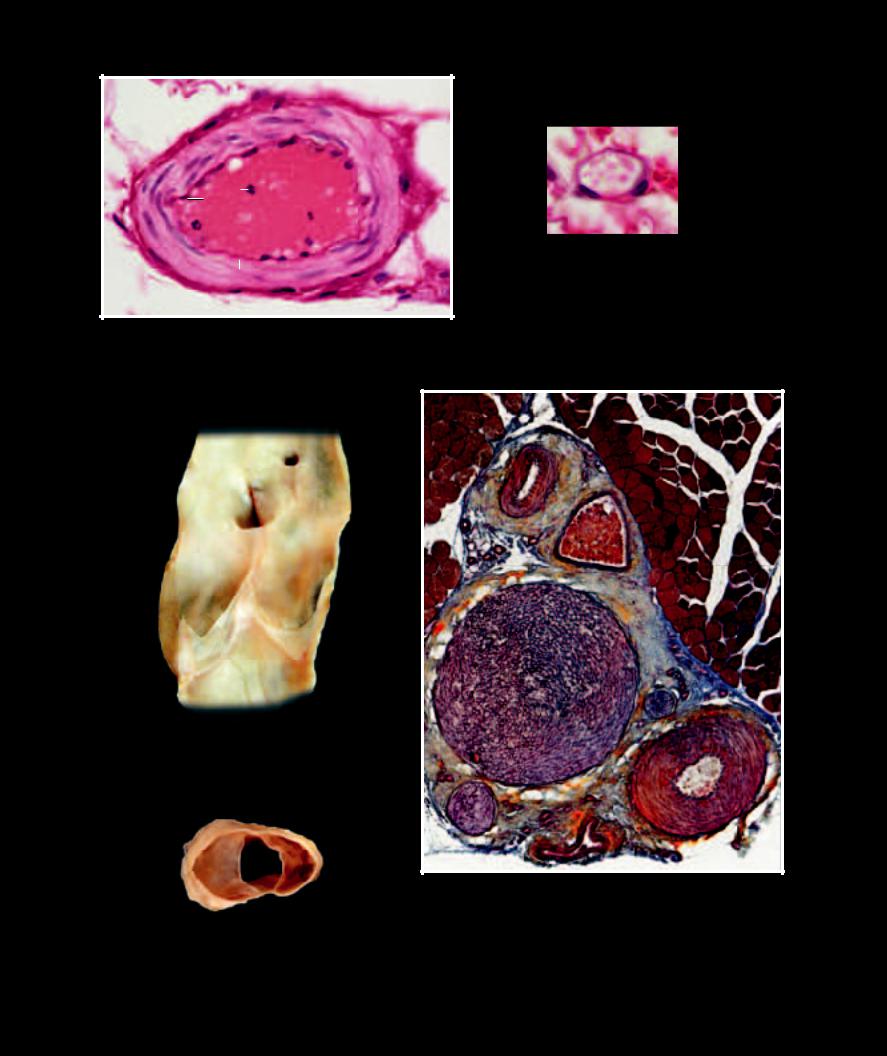
5
4
1
6
7
1 |
1 |
6
Capillary
1000x
2
Arteriole
500x
88
Longitudinal section of vein showing valves
Anterior view
8
Transverse section of vein showing valves
Superior view
10
54
10
6
9
9
4
9
5
Neurovascular bundle — note thin-walled vein filled with red blood cells (6) compared to thick-walled muscular arteries (4)
100x
267
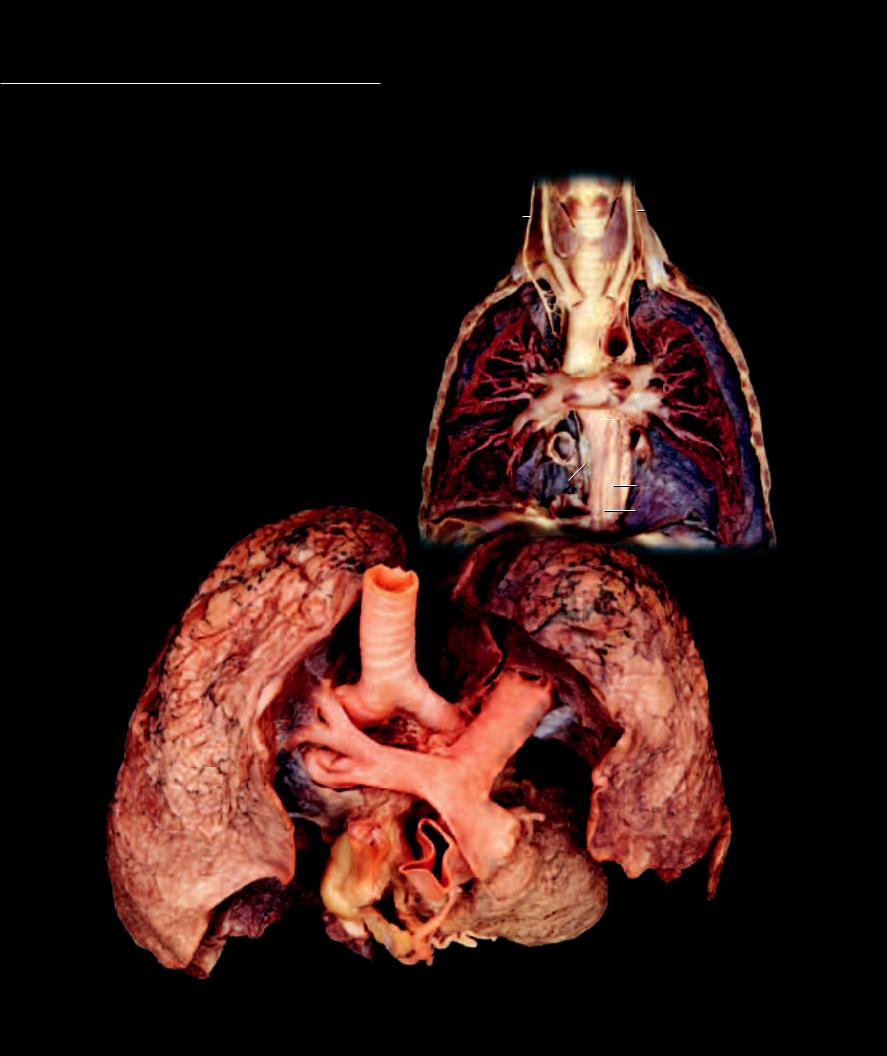
The vascular system consists of two long circular loops of continuous branched tubing that each begin and end with the heart. Leaving the right ventricle and returning to the left atrium is the smaller pulmonary
circulation. This circular loop courses through the lung tissues where its smallest vessels form an extensive interface with the small air sacs of the lungs. This important interface is the site of exchange of O2 and CO2 between the blood and air.
1 |
Heart |
16 |
Superior vena cava |
23 |
|
|
2 |
Pulmonary trunk |
17 |
Inferior vena cava |
|
|
|
|
|
|||||
3 |
Right pulmonary artery |
18 |
Trachea |
|
|
|
4 |
Left pulmonary artery |
19 |
Right principal bronchus |
|
|
|
5 |
Right superior pulmonary vein |
20 |
Left principal bronchus |
13 12 |
||
6 |
Right inferior pulmonary vein |
21 |
Esophagus |
|||
7 |
Left superior pulmonary vein |
22 |
Thyroid gland |
|
|
|
8 |
Left inferior pulmonary vein |
23 |
Vagus nerve |
|
|
|
9 |
Aorta |
24 |
Pulmonary plexus |
|
|
|
10 |
Right coronary artery |
25 |
Posterior vagal trunk |
|
|
|
11 |
Left coronary artery |
26 |
Esophageal plexus |
|
|
|
12 |
Right common carotid artery |
27 |
Anterior vagal trunk |
|
|
|
13 |
Right subclavian artery |
28 |
Anterior scalene muscle |
|
|
|
14 |
Left common carotid artery |
29 |
Cricothyroid muscle |
3 |
||
15 |
Left subclavian artery |
|
|
|||
|
|
|
|
6 |
||
25
17
18
19 20
7
4
3
5
11
2
9
16
10 |
1 |
|
Dissections of pulmonary trunk, arteries, and veins
Anterosuperior view below, anterior view above
268
29
23
22
28
14
18
15
9
4
20
24
21 8
26
27

The left ventricle pumps blood into the much larger systemic circulation, which is distributed throughout all the body’s tissues. Unlike the smaller pulmonary
circuit, the extensive systemic circuit serves a multitude of functions before returning to the right atrium:
(1) it distributes the necessary nutrients and other supplies to all the body cells while removing their metabolic wastes; (2) it acquires metabolic fuel through the lining of the digestive system to distribute throughout the body; (3) it expels wastes and excess water and adjusts the body’s electrolyte composition through its association with the tubes of the kidney; (4) it distributes generated heat throughout the body and plays an important role in adjusting heat loss to the external environment as it courses through the skin; and (5) it distributes hormones, regulatory chemical-messenger molecules secreted by endocrine glands, to various sites of action throughout the body.
1 |
Aorta |
|
|
|
|
21 |
Common iliac arteries |
|
|
|
|
|
|
|
|
|
|
|
|
|
|
|
|
|
|
|
|
|
|
|
|
|
|
|
|
|||||
2 |
Brachiocephalic artery |
|
|
22 |
Internal iliac arteries |
3 |
|
|
|
|
|
6 |
|
|
|
|
|
|
|
|
|
|
||||||||||||||||||
|
|
|
|
|
|
|
|
|
|
|
|
|
|
|
|
|
||||||||||||||||||||||||
3 |
Right common carotid artery |
23 |
External iliac artery |
|
|
|
|
|
|
|
|
|
|
|
|
|
|
|
|
|
|
|
|
|||||||||||||||||
|
|
|
|
|
|
|
|
|
|
|
|
|
|
|
|
|
|
|
|
|
|
|
|
|
|
|
|
|||||||||||||
4 |
Right subclavian artery |
|
|
24 |
Femoral artery |
4 |
|
|
|
|
7 |
|
|
|
|
|
|
|
|
|||||||||||||||||||||
5 |
Right internal thoracic artery |
25 |
Deep femoral artery |
|
|
|
|
|
|
|
|
|
|
|
|
|||||||||||||||||||||||||
|
|
|
|
|
|
|
|
|
|
|
|
|
|
|
|
|
|
|||||||||||||||||||||||
6 |
Left common carotid artery |
26 |
Popliteal artery |
|
|
|
|
|
|
|
|
|
|
2 |
|
|
|
|
|
|
|
|
|
|
|
|
|
|
|
|||||||||||
|
|
|
|
|
|
|
|
|
|
8 |
|
|
|
|
|
|
|
|
||||||||||||||||||||||
7 |
Left subclavian artery |
|
|
27 |
Azygos vein |
|
|
|
|
|
|
|
|
|
|
|
|
|
|
|
|
|
|
|
||||||||||||||||
|
|
|
|
|
|
|
|
|
|
|
|
|
1 |
|
|
|
|
|
|
|
|
|
|
|
|
|
|
|||||||||||||
8 |
Left axillary artery |
|
|
|
28 |
Thyroid gland |
|
|
|
|
|
|
|
|
|
|
|
|
|
|
|
|
|
|
|
|
|
|
|
|
||||||||||
|
|
|
|
|
|
|
|
|
|
|
|
|
|
|
|
|
|
|
|
|
|
|
|
|
|
|
|
|
|
|
||||||||||
9 |
Left brachial artery |
|
|
|
29 |
Trachea |
|
|
|
|
|
|
|
|
|
|
|
|
|
|
|
|
|
|
|
|
|
|
|
|
|
|
|
|
|
|||||
10 |
Left ulnar artery |
|
|
|
30 |
Ligamentum arteriosum |
|
|
|
|
|
|
|
|
|
|
|
|
|
|
|
|
|
|
|
|
|
|
|
|
|
|
|
|
||||||
11 |
Left radial artery |
|
|
|
31 |
Vagus nerve |
|
|
|
|
|
|
|
|
|
|
|
|
|
|
36 |
|
|
|
|
|
|
|
|
|||||||||||
12 |
Left radial recurrent artery |
32 |
Phrenic nerve |
27 |
|
|
|
|
|
|
|
|
|
|
|
|
||||||||||||||||||||||||
|
|
|
|
|
|
|
|
|
|
|||||||||||||||||||||||||||||||
13 |
Coeliac trunk |
|
|
|
33 |
Anterior scalene muscle |
|
|
|
|
|
|
|
|
|
|
9 |
|
|
|
|
|
|
|
|
|||||||||||||||
|
|
|
|
|
|
|
|
|
|
|
|
|
|
|
|
|
|
|
|
|
||||||||||||||||||||
14 |
Common hepatic artery |
34 |
Brachialis muscle |
34 |
|
|
|
|
|
|
|
|
|
|
|
|
|
|
|
|
|
|
|
|
|
|
|
|
|
|
|
|||||||||
15 |
Left gastric artery |
|
|
|
35 |
Brachioradialis muscle |
|
|
|
|
|
|
|
|
|
|
|
|
|
|
|
|
|
|
|
|
|
|
|
|
|
|
|
|||||||
|
|
|
|
|
|
|
|
|
|
|
|
|
1 |
|
|
|
|
|
|
|
|
|
|
|
|
|
||||||||||||||
16 |
Splenic artery |
|
|
|
36 |
Innermost intercostal muscles |
|
|
|
|
|
|
|
|
|
|
|
|
|
|
|
|
|
|
|
|
|
|
|
|||||||||||
17 |
Superior mesenteric artery |
37 |
Quadratus lumborum muscle |
|
|
|
|
|
|
|
|
|
|
15 |
|
|
|
|
|
|
|
|
|
|||||||||||||||||
18 |
Right renal artery |
|
|
|
38 |
Psoas major muscle |
13 |
|
|
|
|
|
16 |
|
|
|
|
|
12 |
|||||||||||||||||||||
|
|
|
14 |
|
|
|
|
|
|
|
|
|
|
|
|
|
|
|
|
|
||||||||||||||||||||
19 |
Left renal artery |
|
|
|
39 |
Clavicle |
35 |
|
|
|
|
|
|
|
|
|
|
|
|
|
|
|
|
|||||||||||||||||
|
|
|
|
|
|
|
|
|
|
|
|
|
|
|
|
|
|
|
|
|
|
|
|
|
||||||||||||||||
20 |
Inferior mesenteric artery |
40 |
First rib |
|
18 |
|
|
|
|
|
|
|
|
|
19 |
|
|
|
|
|
|
|
|
|||||||||||||||||
|
|
|
|
|
|
|
|
|
|
|
|
|
|
|
|
|
|
|||||||||||||||||||||||
|
|
|
|
|
|
|
|
|
|
|
|
|
|
|
|
|
|
|
|
|
|
|
17 |
|
|
|
|
|
|
|
|
|||||||||
|
|
|
|
|
|
|
|
|
|
|
|
|
|
|
|
|
|
|
|
|
|
|
37 |
|
|
|
|
|
|
|
|
|||||||||
|
|
|
|
|
|
|
|
|
|
|
|
|
|
|
|
|
|
|
|
|
|
|
|
|
|
20 |
|
|
|
|
|
|
|
11 |
||||||
|
|
|
|
|
|
|
|
|
|
|
|
|
|
|
|
|
|
|
|
|
|
|
|
|
|
|
|
|
|
|
||||||||||
|
|
|
|
|
|
|
|
|
|
|
|
|
|
|
|
|
|
|
|
|
|
|
10 |
|
|
|
|
|
||||||||||||
|
|
|
|
|
|
|
|
|
|
|
|
|
|
|
|
|
|
|
|
|
|
|
|
|
||||||||||||||||
|
|
|
|
|
|
|
|
|
|
|
|
|
|
|
|
|
|
|
|
|
|
|
21 |
|
|
|
|
|
|
|
|
|
|
|||||||
|
|
|
|
|
|
|
|
|
|
|
|
|
|
|
|
|
|
|
|
|
|
|
38 |
|
|
|
|
|
|
|
|
|||||||||
|
|
|
|
|
|
|
|
|
33 |
|
|
|
|
|
|
|
|
|
|
|
|
|
|
22 |
|
|
|
|
|
|
|
|
|
|
|
|
|
|
||
|
|
|
|
|
|
|
|
|
|
|
|
|
|
|
|
|
|
|
|
|
|
|
|
|
|
|
|
|
|
|
|
|
|
|
|
|
||||
|
|
|
|
|
|
|
|
|
|
|
|
|
|
|
|
|
|
|
|
|
|
|
23 |
|
|
|
|
|
|
|
|
|||||||||
|
|
|
|
|
|
28 |
|
|
7 |
|
39 |
|
|
|
|
|
|
|
|
|
|
|
|
|
|
|
|
|
|
|
|
|
|
|
|
|
|
|
|
|
|
|
|
|
|
|
|
|
|
|
|
|
|
|
|
|
|
|
|
|
|
|
|
|
|
|
|
|
|
|
|
|
|
|
|
|
|
|
|||
|
4 |
|
3 |
|
|
|
|
|
|
|
|
|
|
|
|
|
|
|
|
|
|
24 |
|
|
|
|
|
|
|
|
||||||||||
|
|
|
|
|
|
|
|
|
|
|
|
|
|
|
|
|
|
|
|
|
|
|
|
|
|
|
|
|
|
|
|
|
|
|
|
|
|
|
|
|
|
|
|
|
4 |
|
|
|
|
40 |
|
|
8 |
|
|
|
|
|
|
|
|
|
|
|
|
|
|
|
|
|
|
|
|
|
|
|
|
|
|
|
|
|
|
|
|
|
29 |
|
|
|
|
|
|
|
|
|
|
|
|
|
|
|
|
|
|
|
|
|
|
|
|
|
|
|
|
|
|
|
|
|
|
|
|
|
|
|
|
7 |
|
|
|
|
|
25 |
|
|
|
|
|
|
|
|
|
|
|
|
|
|
|
|
|
|
|
|
|
|
|
|
|
|
|
||
|
|
|
|
2 |
|
|
31 |
|
|
|
|
|
|
|
|
|
|
|
|
|
|
|
|
|
|
|
|
|
|
|
|
|
|
|
|
|
|
|||
|
|
|
|
|
|
|
|
|
|
|
|
|
|
|
|
|
|
|
|
|
|
|
|
|
|
|
|
|
|
|
|
|
|
|
|
|||||
|
|
|
|
|
6 |
|
|
|
|
|
|
|
|
|
|
|
|
|
|
|
|
|
|
|
|
|
|
|
|
|
|
|
|
|
|
|
|
|
||
|
|
|
|
|
|
|
|
|
|
|
|
|
|
|
|
|
|
|
|
|
|
|
|
|
|
|
|
|
|
|
|
|
|
|
|
|||||
|
|
|
|
|
|
|
|
|
|
|
|
|
|
|
|
|
|
|
|
|
|
|
|
|
|
|
|
|
|
|
|
|
|
|
|
|
|
|
||
|
5 |
|
|
|
1 |
|
|
|
|
|
|
|
|
|
|
|
|
|
|
|
|
|
|
|
|
|
|
|
|
|
|
|
|
|
|
|
|
|
|
|
|
|
|
|
|
|
|
|
|
|
|
|
|
|
|
|
|
|
|
|
|
|
|
|
|
|
|
|
|
|
|
|
|
|
|
|
|
|
|
||
|
|
|
|
|
|
|
|
|
|
|
|
|
|
|
|
|
|
|
|
|
|
|
|
|
|
|
|
|
|
|
|
|
|
|
|
|
|
|
|
|
|
|
|
|
|
|
|
|
|
|
|
32 |
|
|
|
|
|
|
|
|
|
|
|
|
|
|
|
|
|
|
|
|
|
|
|
|
|
|
|
|
|
|
|
|
|
|
|
|
|
|
|
|
|
|
|
|
|
|
|
|
|
|
|
|
|
|
|
|
|
|
|
|
|
|
|
|
|
|
|
|
||
|
|
|
|
|
|
|
|
|
|
|
|
|
|
|
|
|
|
|
|
|
|
|
|
|
|
|
|
|
|
|
|
|
|
|
|
|
|
|
|
|
|
|
|
|
|
|
|
|
|
|
|
|
|
|
|
|
|
|
|
|
|
|
|
|
|
|
|
|
|
|
|
|
|
|
|
|
|
|
|
|
|
|
|
|
|
|
|
30 |
|
|
|
|
|
|
|
|
|
|
|
|
|
|
|
|
|
|
|
|
|
|
|
|
|
|
|
|
|
|
|
|
|
|
|
|
|
|
|
|
|
|
|
|
|
|
|
26 |
|
|
|
|
|
|
|
|
|
|
|
|
|
|
|
|
|
|
|
|
|
|
|
|
|
|
|
|
|
|
|
|
|
|
|
|
|
|
|
|
|
|
|
|
|
|
|
|
|
|
|
|
|
|
|
|
|
|
|
|
|
|
|
|
|
|
||
Dissection of aortic arch and its branches |
Dissection of major arterial pathways |
Anterior view |
Anterior view |
269

The coronary arteries are the fi rst branches of the aorta. These important vessels provide the constantly needed blood supply to the heart. The left coronary artery is, on average, larger than the right coronary artery and supplies a greater percentage
of the heart tissue. Accompanying the branches of the coronary arteries, a series of cardiac veins emerge from the capillaries of the heart to return blood to the right atrial chamber, either by entering directly or by joining the large coronary sinus, which enters the right atrium from the posterior side.
1 |
Coronary sinus |
15 |
Pulmonary trunk |
|
|
|
2 |
Right coronary artery |
16 |
Superior vena cava |
27 |
||
3 |
Conus arteriosus branch |
17 |
Left atrium |
25 |
|
|
4 |
Marginal branch |
18 |
Right atrium |
26 |
|
|
|
|
|
||||
5 |
Anterior interventricular artery |
19 |
Right ventricle |
|
|
|
6 |
Lateral branches |
20 |
Left ventricle |
|
|
|
7 |
Circumflex branch of left coronary |
21 |
Pulmonary veins |
|
|
|
8 |
Posterior interventricular artery |
22 |
Pulmonary artery |
|
|
|
9 |
Anterior cardiac vein |
23 |
Inferior vena cava |
|
|
|
10 |
Great cardiac vein |
24 |
Ligamentum arteriosum |
16 |
|
|
11 |
Posterior vein of left ventricle |
25 |
Brachiocephalic artery |
|
24 |
|
|
|
|||||
|
||||||
12 |
Middle cardiac vein |
26 |
Left common carotid artery |
|
|
|
13 |
Oblique vein |
27 |
Left subclavian artery |
22 |
||
14 |
Aorta |
|
|
14 |
|
|
|
|
|
|
|
|
|
|
|
|
|
15 |
|
|
|
|
|
|
|
|
3 |
|
|
|
7 |
|||||||
|
|
|
16 |
|
|
|
|
|
|
|
|
|
|
|
|
6 |
|
|
|
|
|
|
|
|
|
|
|
|
|
|
|
|
|
||
|
|
|
|
|
|
|
|
|
|
|
|
|
|
|
|
|
|
14 |
|
|
|
|
|
|
|
|
|
|
4 |
10 |
|
||||
|
|
|
|
|
|
||||||||||||
|
|
|
|
|
|
2 |
|
|
|
|
|
|
|
|
|
|
|
24 |
|
|
|
|
18 |
|
|
|
|
|
|
|
|
|
5 |
|
|
|
|
|
|
|
|
|
|
|
|
|
|
|
|
||||
|
|
|
|
|
|
|
|
|
|
|
|
|
|
|
|||
|
|
22 |
|
|
9 |
|
|
|
|
|
|
||||||
|
|
|
|
|
|
|
|
|
|
|
|||||||
|
|
|
|
|
|
|
|
|
|
|
|
||||||
22 |
|
|
|
|
19 |
|
|
||||||||||
|
|
|
|
|
|||||||||||||
21 |
|
|
|
|
|
|
|
|
|
|
4 |
20 |
|
||||
21 |
|
|
|
|
|
|
|
|
|
||||||||
|
|
|
|
|
|
||||||||||||
|
|
|
|
|
|
|
|
|
|
|
|
|
|
|
|||
|
|
|
|
9 |
|
|
|||||||||||
17 |
21 |
|
|
|
|
||||||||||||
|
|
4 |
|
|
|
|
|
|
|
|
|
|
|
||||
|
|
|
|
|
|
|
|
|
|
|
|
|
|
|
|
|
|
21 |
|
|
|
|
|
|
|
|
|
|
|
|
|
|
|
|
|
|
|
|
|
|
18 |
|
|
|
|
|
|
|
|
|
|
|
|
13 |
|
|
|
|
|
|
|
|
|
|
|
|
|
|
|
||
7 |
|
|
|
|
|
|
|
|
|
|
|
|
|
|
|
|
|
7 |
|
|
|
|
|
Dissection of coronary arteries and cardiac veins |
|
||||||||||
|
|
|
|
|
|
|
|||||||||||
1 |
|
23 |
|
|
|
|
|
|
|
|
|
Anterior view |
|
|
|||
|
|
|
|
|
|
|
|
|
|
|
|
|
|
||||
11 |
11 |
|
|
|
|
|
|
|
|
|
|
|
|
|
|
||
11 |
|
|
|
|
|
|
|
|
|
|
|
|
|
|
|
|
|
20 |
8 |
|
|
|
|
|
|
|
|
|
|
|
|
|
|
||
|
|
|
12 |
|
|
|
|
|
|
|
|
|
|
|
|
|
|
Dissection of coronary arteries, coronary sinus, and cardiac veins
Posterior view
270
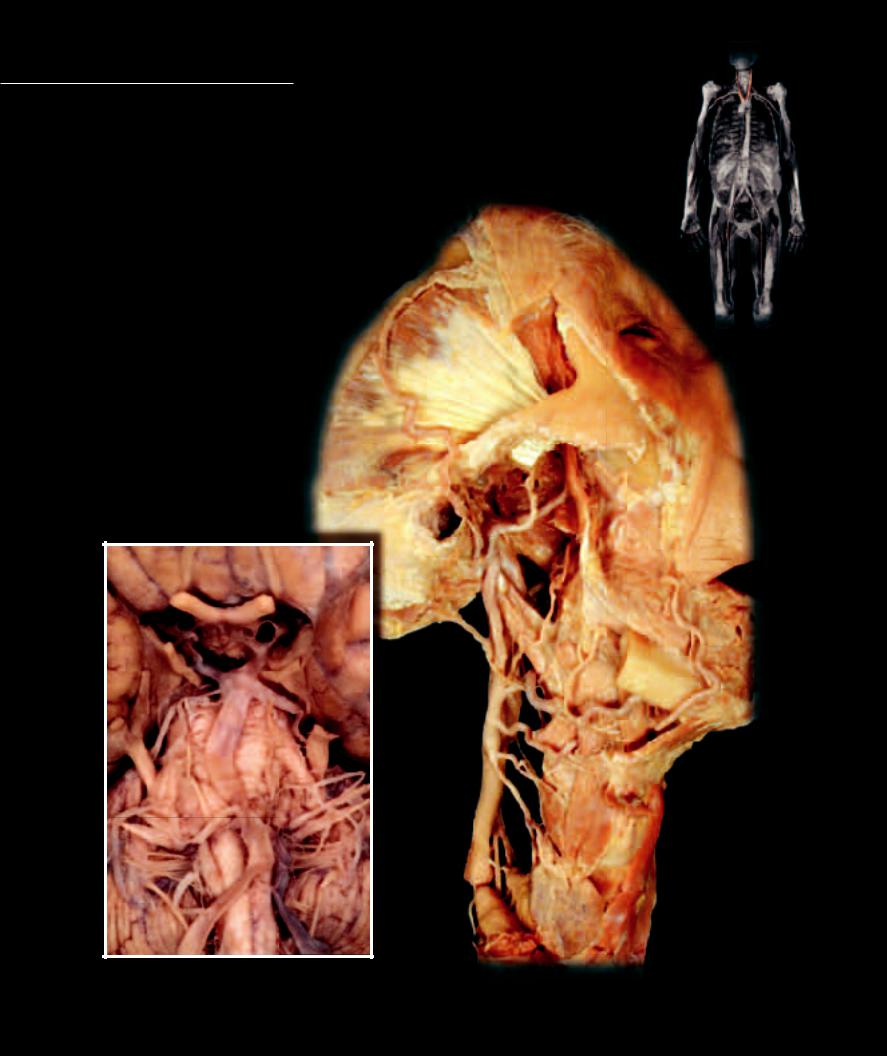
Like the heart, which needs a constant, uninterrupted blood supply, the brain tissue also must be guaranteed of a continuous perfusion in order to maintain its crucial functions. The
common carotid arteries, arising from the aortic arch, bifurcate into external and internal carotids. The external carotid supplies all tissues of the head except the brain, while the function of the internal carotid is to supply the brain. Because of the brain’s critical vascular needs the internal carotid artery has a partner, the vertebral artery, which courses cranially from the subclavian artery to assist with the essential blood supply to the brain.
1 |
Internal carotid artery |
|
|
2 |
Basilar artery |
|
|
3 |
Vertebral artery |
|
|
4 |
Posterior cerebral artery |
|
|
5 |
Posterior communicating artery |
|
|
6 |
Middle cerebral artery |
|
|
7 |
Posterior inferior cerebellar artery |
|
|
8 |
Posterior superior cerebellar artery |
|
|
9 |
Common carotid artery |
|
|
10 |
External carotid artery |
|
|
11 |
Superior thyroid artery |
|
|
12 |
Ascending pharyngeal artery |
|
|
13 |
Lingual artery |
|
|
14 |
Facial artery |
|
|
15 |
Occipital artery |
|
|
16 |
Posterior auricular artery |
|
|
17 |
Superficial temporal artery |
25 |
|
18 |
Transverse facial artery |
||
17 |
|||
|
|
19Maxillary artery
20Optic chiasm
21Thyroid gland
22Trigeminal nerve
23 |
Lateral pterygoid muscle |
|
|
18 19 |
|
|
24 Temporal lobe of cerebrum |
|
|
|
|||
25 |
Zygomatic arch |
|
|
|
|
|
|
|
|
|
|
23 |
|
|
|
|
|
|
1 |
|
|
|
|
|
16 |
|
|
|
6 |
20 |
|
|
|
|
|
|
1 |
15 |
|
|
|
|
|
|
|
|
||
|
|
|
|
12 |
|
|
|
24 |
|
|
|
|
|
|
|
5 |
24 |
|
|
|
|
|
|
|
14 |
||
|
|
|
|
|
|
|
|
|
|
4 |
10 |
14 |
14 |
|
|
|
|
|
|
|
|
22 |
2 |
22 |
11 |
13 |
|
|
|
|
|
|
||
8
9
7 |
21 |
3 |
3 |
Dissection of basilar artery |
Dissection of branches of external carotid artery |
Inferior view |
Lateral view
271
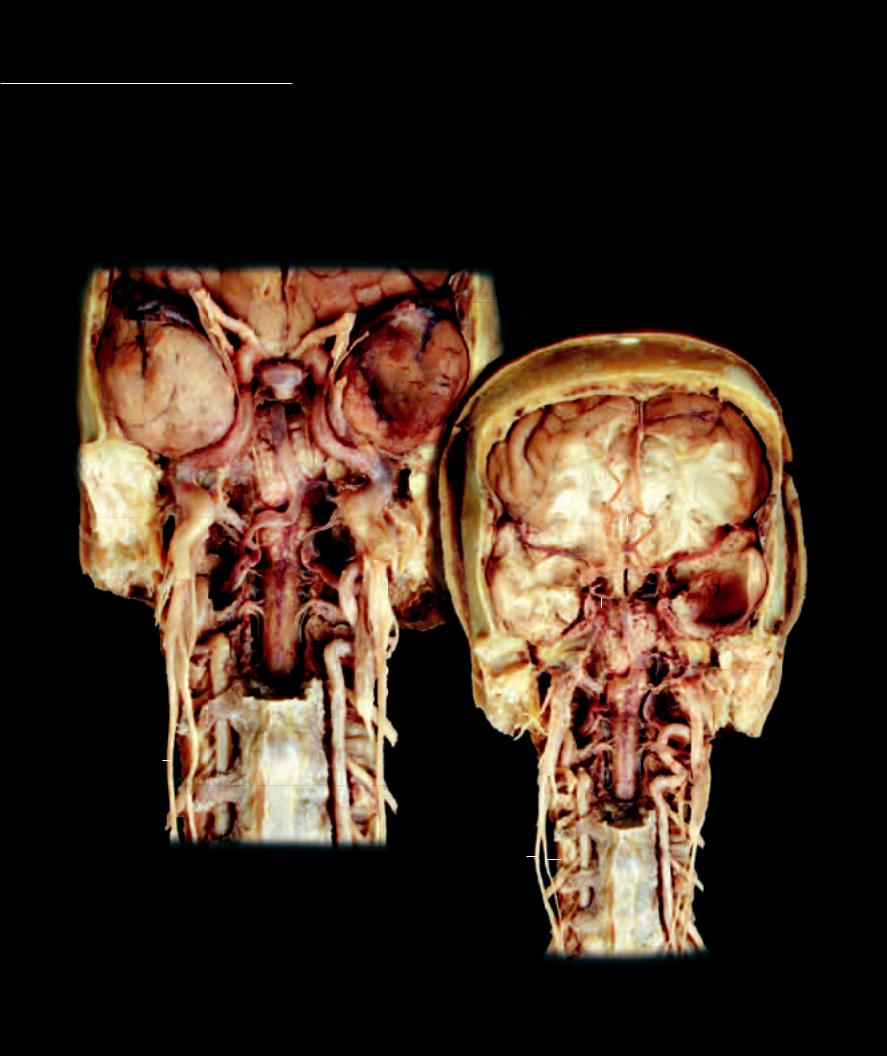
Head Vessels
1 |
Internal carotid artery |
8 |
Cerebral veins |
15 |
Confluence of the sinuses |
22 |
Pituitary gland |
2 |
Vertebral artery |
9 |
Cerebellar veins |
16 |
Dura mater |
23 |
External acoustic meatus |
3 |
Basilar artery |
10 |
Superior sagittal sinus |
17 |
Pia-arachnoid mater |
24 |
Pons |
4 |
Middle cerebral artery |
11 |
Transverse sinus |
18 |
Spinal cord |
25 |
Frontal lobe of cerebrum |
5 |
Anterior cerebral artery |
12 |
Inferior sagittal sinus |
19 |
Vertebral body |
26 |
Vagus nerve |
6 |
Anterior communicating artery |
13 |
Sigmoid sinus |
20 |
Cervical transverse process |
27 |
Cervical sympathetic trunk |
7 |
Posterior communicating artery |
14 |
Opening of straight sinus |
21 |
Temporal lobe of cerebrum |
28 |
Superior cervical ganglion |
25
1
22 |
21 |
|
|
|
1 |
25 |
|
|
|
|
|
|
3 |
|
|
|
|
|
|
|
24 |
|
|
|
|
|
|
|
|
|
5 |
|
|
|
1 |
2 |
|
|
|
|
|
|
|
|
|
|
|
|
|
|
|
|
|
|
6 |
||
|
|
|
|
|
4 |
||
|
|
|
|
|
1 |
|
|
|
|
|
|
21 |
1 |
||
|
|
|
18 |
|
|
|
|
|
|
|
|
|
|
||
|
|
|
|
|
|
|
|
|
|
|
|
7 |
|
||
|
|
|
|
|
3 |
||
|
|
|
|
|
24 |
|
|
|
|
|
28 |
23 |
2 |
||
|
|
|
|
||||
|
20 |
19 |
|
|
|
|
|
|
2 |
|
|
|
|
||
|
2 |
|
|
2 |
|||
26 |
|
|
|
|
18 |
||
27 |
|
|
|
|
|
||
|
|
|
|
|
|
||
|
20 |
|
|
28 |
|||
|
|
|
|
20 |
19 |
||
|
|
|
|
|
2 |
||
26 |
|
|
|
27 |
|
|
|
||
|
|
|
||
|
20 |
|||
Deep dissection series of head with facial and anterior neck anatomy |
|
|
|
|
removed exposing internal carotid and vertebral arteries |
|
|
|
|
Anterior views |
|
|
|
|
272
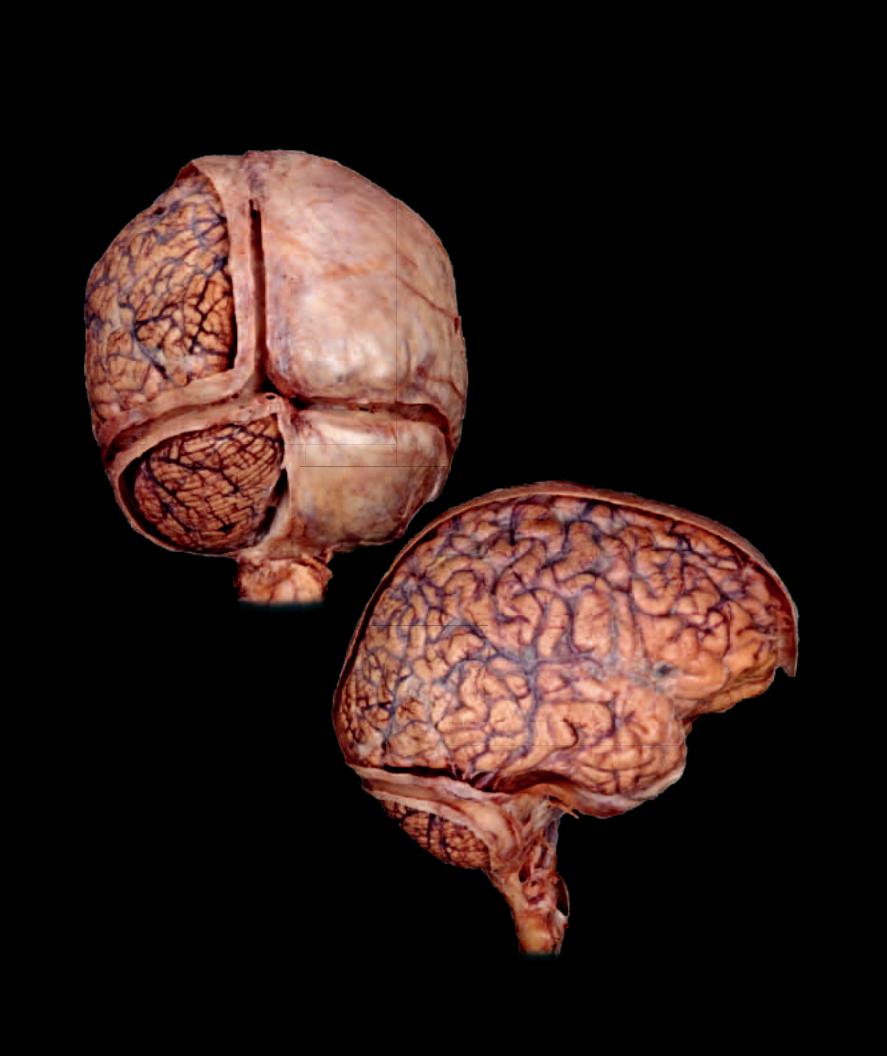
Unlike the internal and external carotid arteries, the internal and external jugular veins form a wide array of collateral circuitry. The major structural difference of the venous pathways in the head is the existence of dural venous sinuses within the skull. The dural venous sinuses are non-collapsible, endothelial lined spaces within the tough meningeal dura mater. All the smaller veins draining capillaries within the brain tissue enter into the dural venous sinuses. These dural sinuses converge with one another throughout the skull to exit the cranial vault via the internal jugular vein.
8
16
17
10
8
|
14 |
|
15 |
11 |
11 |
|
9
12
8
8
8
17
11
913
Dissections of dural venous sinuses and cerebral veins
Posterior view (top), lateral view (bottom)
273
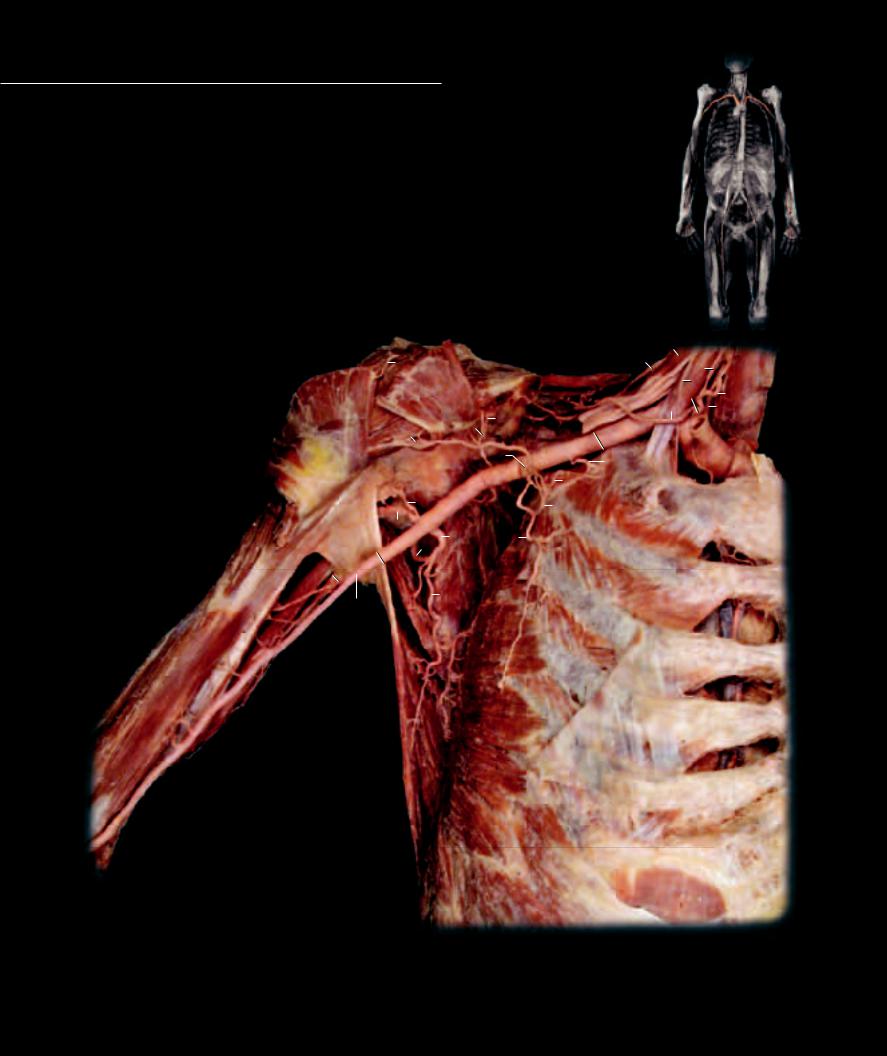
The arterial pathway into the upper limb consists of a single, major arterial roadway that gradually tapers as
it gives rise to the various branches that supply the tissues of the limb. This large arterial roadway begins as the subclavian artery, takes on regional names — the axillary artery and brachial artery — as it tapers distally, then branches into the radial and ulnar arteries, which course through the antebrachium, paralleling the bones of the same names. The radial and ulnar arteries terminate as the collateral arches in the hand. This central pathway through the limb is the sole blood supply to this region, supplying the integument, muscles, bones, joints, and connective tissues of the upper limb. The deep venous pathways follow the arteries and have similar names. However, superfi cial veins that have no arterial counterparts aid the deep veins in returning blood to the heart.
|
|
|
|
|
|
|
|
|
|
|
|
|
|
|
|
|
|
|
|
|
|
|
|
28 |
|
|
|
|
13 |
|
|
|
|
|
|
|
|
|
|
|
|
|
|
|
|
|
9 |
|
|
|
|
|
|
|
30 |
|
|
|
|
|
38 |
|
|
|
|
|
|
|
37 |
|
|
||||||
|
|
|
|
|
|
|
|
|
|
|
|
|
|
|
|
|
|
|
|||||||
31 |
|
|
|
|
|
|
|
|
|
|
|
|
|
|
|
|
|
|
8 |
||||||
|
|
|
|
|
|
|
|
|
|
|
|
|
|
|
|
|
|
|
|
|
|
|
|||
29 |
16 |
|
|
|
14 |
|
|
15 |
|
|
|
|
|
|
|
|
4 |
|
27 |
|
|||||
|
|
|
|
|
|
|
|
|
|
|
|
|
|
|
|||||||||||
|
|
|
|
|
|
|
|
|
|
|
|
|
|
|
|||||||||||
|
|
|
|
|
|
|
|
|
|
|
|
|
|
|
|
|
|
|
|
|
|||||
|
|
|
|
|
|
|
|
|
|
|
|
|
|
|
|
|
|
|
|
|
|
|
|
|
|
|
|
|
|
|
|
|
|
|
|
12 |
|
10 |
|
|
11 |
39 |
|
|
|
||||||
|
|
|
|
|
21 |
|
|
|
|
10 |
|
|
|
|
|
|
13 |
|
|
|
|
||||
|
|
|
|
|
|
|
|
|
|
|
|
|
|
|
|
|
|
|
|||||||
|
|
|
|
|
|
|
|
|
|
|
|
|
|
|
|
|
|||||||||
|
|
|
|
|
|
|
|
|
|
|
|
|
|
|
|
13 |
|
|
|
|
|
|
|||
|
|
|
|
|
|
|
|
|
|
|
|
|
|
|
|
|
|
|
|
||||||
|
|
|
|
|
|
|
|
|
|
|
|
|
|
|
|
|
|
||||||||
|
|
|
|
|
10 |
|
|
|
|
|
|
|
|
|
|
|
|
|
|
|
|
|
|
|
|
|
|
22 |
|
|
|
18 |
|
|
|
17 |
|
|
|
|
|
|
|
|
|
|
|
|
|||
|
|
|
|
|
|
|
|
|
|
|
|
|
|
|
|
|
|
|
|
|
|
||||
|
|
|
|
|
19 |
|
|
32 |
|
|
|
|
|
|
|
|
|
|
|
|
|
||||
|
|
|
|
|
|
|
|
|
|
|
|
|
|
|
|
|
|
|
|
||||||
|
|
|
|
|
|
|
|
|
|
|
|
|
|
|
|
|
|
|
|
|
|
||||
24 |
|
33 |
|
|
|
|
|
|
|
|
|
|
|
|
|
|
|
|
|
|
|
|
|
||
|
|
|
|
|
20 |
|
|
|
|
|
|
|
|
|
|
|
|
|
|
|
|
||||
|
|
|
|
|
|
|
|
|
|
|
|
|
|
|
|
|
|
|
|
|
|
|
|
||
23 |
|
|
|
|
|
|
|
|
|
|
|
|
|
|
|
|
|
|
|
|
|
|
|||
|
|
|
|
|
|
|
|
|
|
|
|
|
|
|
|
|
|
|
|
|
|
|
|
||
|
|
34 |
|
|
|
|
|
|
|
|
|
|
|
|
|
|
|
|
|
|
|
|
|
|
|
|
|
|
|
|
|
|
|
|
|
35 |
|
|
|
|
|
|
|
|
|
|
|
|
|
||
Dissection of subclavian and axillary arteries
Anterior view
7
36
65
3
2
1
26 
 25
25
274
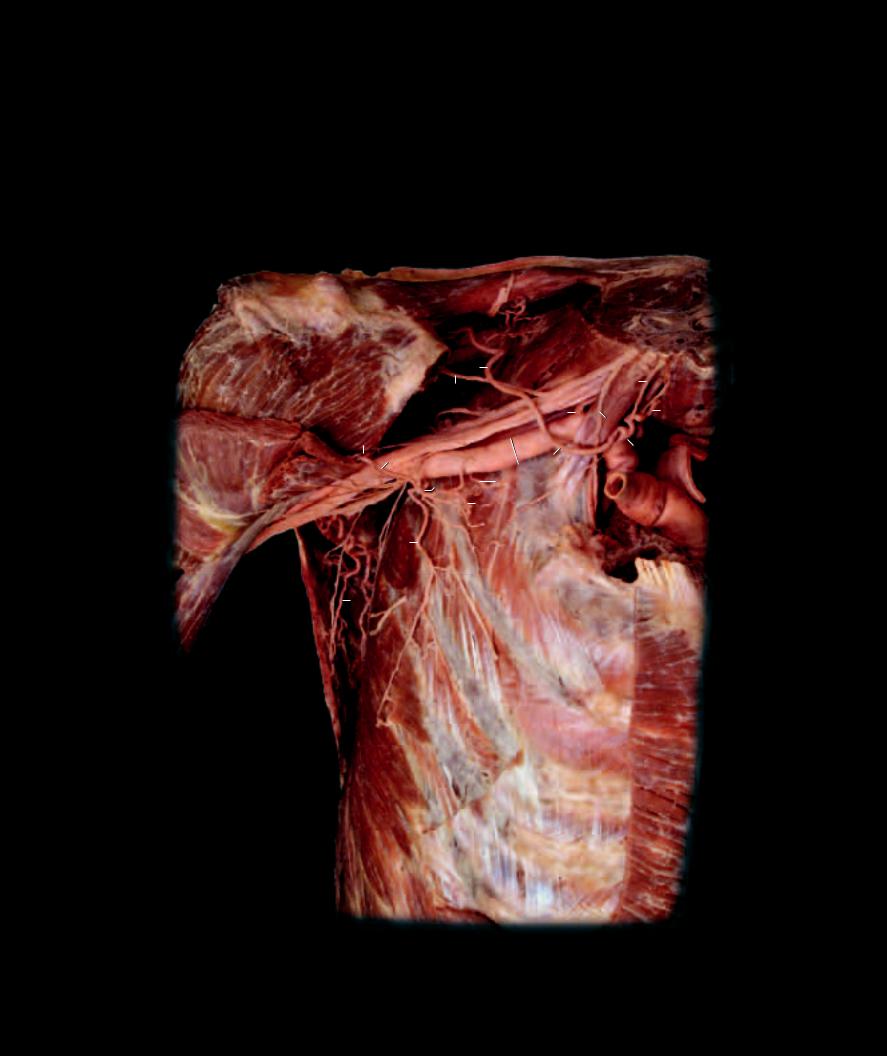
1 |
Brachiocephalic artery |
11 |
Superior thoracic artery |
21 |
Posterior circumflex humeral artery |
31 |
Pectoralis major muscle |
2 |
Common carotid artery |
12 |
Thoracoacromial trunk |
22 |
Anterior circumflex humeral artery |
32 |
Subscapularis muscle |
3 |
Vertebral artery |
13 |
Pectoral artery |
23 |
Brachial artery |
33 |
Teres major muscle |
4 |
Subclavian artery |
14 |
Acromial artery |
24 |
Deep artery of arm |
34 |
Latissimus dorsi muscle |
5 |
Thyrocervical trunk |
15 |
Clavicular artery |
25 |
Internal thoracic artery |
35 |
Serratus anterior muscle |
6 |
Inferior thyroid artery |
16 |
Deltoid artery |
26 |
Internal thoracic vein |
36 |
Phrenic nerve |
7 |
Ascending cervical artery |
17 |
Lateral thoracic artery |
27 |
Anterior scalene muscle |
37 |
Brachial plexus |
8 |
Suprascapular artery |
18 |
Subscapular artery |
28 |
Middle scalene muscle |
38 |
Clavicle |
9 |
Dorsal scapular artery |
19 |
Circumflex scapular artery |
29 |
Deltoid muscle |
39 |
First rib |
10 |
Axillary artery |
20 |
Thoracodorsal artery |
30 |
Pectoralis minor muscle |
40 |
Suprascapular nerve |
|
|
|
|
38 |
|
|
|
|
|
|
|
|
|
|
|
|
|
|
|
|
|
|
|
|
8 |
|
|
|
|
|
28 |
7 |
|
|
|
|
|||||
|
|
|
|
|
|
|
|
|
|
|
|
|
||||||||
|
|
|
|
|
|
|
|
|
|
|
|
|
|
|
|
|
|
|
|
|
29 |
|
|
|
40 |
|
|
|
|
|
|
|
|
|
|
|
|
|
|||
|
|
|
|
|
|
|
|
|
37 |
3 |
|
|||||||||
|
|
|
|
|
|
|
|
|
|
|
|
|
9 |
|
|
27 |
|
|
|
6 |
|
|
|
|
|
|
|
|
|
|
|
|
|
|
|
36 |
|
|
|
||
|
|
|
|
|
|
|
|
|
|
|
|
|
|
|
|
|
|
|||
|
|
|
|
|
|
|
|
|
|
|
|
|
4 |
|
|
|
|
|
|
|
|
|
15 |
|
|
|
|
|
|
|
|
|
|
|
|
|
|
|
|
||
|
|
|
|
|
|
|
|
|
|
|
|
|
|
|
|
|
|
|
||
|
|
|
|
|
|
|
|
|
|
|
|
|
|
|
|
5 |
|
|
|
|
|
|
|
|
|
|
|
|
|
|
|
|
|
|
|
|
|
|
|
||
|
|
14 |
10 |
|
|
|
|
|
|
8 |
|
|
|
|
|
|||||
31 |
30 |
|
|
|
|
|
|
|
|
4 |
|
|
|
|
||||||
|
|
|
|
|
|
|
|
|
|
|
|
|
|
|||||||
|
|
|
|
|
|
|
|
|
|
|
|
|
|
|
|
|
|
|
||
|
|
|
|
12 |
|
|
|
|
|
|
11 |
39 |
|
|
2 |
|
|
|
|
|
|
|
|
|
13 |
|
|
|
|
||||||||||||
|
|
|
|
|
|
|
|
|
|
|
|
|
|
|
|
|||||
|
|
32 |
|
|
|
|
|
|
|
|
1 |
|||||||||
|
|
|
|
|
|
|
|
|
|
|||||||||||
|
|
|
|
|
|
|
|
|
|
|
|
|
|
|||||||
|
|
17 |
|
|
|
|
|
|
|
|
|
|
|
|
|
|
|
|
|
|
|
|
|
|
|
|
|
|
|
|
|
|
|
|
|
|
|
|
|
||
34
20
35
Dissection of subclavian and axillary arteries
Anterosuperior view
275

Superior Limb Vessels
1 |
Brachial artery |
8 |
Deep palmar arch |
15 |
Interosseous membrane |
22 |
Triceps brachii muscle |
2 |
Ulnar artery |
9 |
Cephalic vein |
16 |
Transverse carpal ligament |
23 |
Pectoralis major muscle |
3 |
Radial artery |
10 |
Median cubital vein |
17 |
Supinator muscle |
24 |
Deltoid muscle |
4 |
Anterior interosseous artery |
11 |
Basilic vein |
18 |
Pronator quadratus muscle |
25 |
Deltopectoral groove |
5 |
Superficial palmar arch |
12 |
Median antebrachial vein |
19 |
Flexor digitorum superficialis tendons |
26 |
Serratus anterior muscle |
6 |
Common digital artery |
13 |
Accessory cephalic vein |
20 Flexor digitorum profundus tendons |
27 |
Brachioradialis muscle |
|
7 |
Proper digital artery |
14 |
Brachial vein |
21 |
Biceps brachii muscle |
28 |
Coracobrachialis muscle |
22
2 |
3 |
21
1
16
17
2
3
4
5
15
18
18 18
18 |
6 |
|
2 |
|
|
|
3 |
|
|
7 7
19
8 18
Dissection of palmar arterial arch and branches to digits
Anterior view
Dissection of antebrachial arteries
Anterior view
276
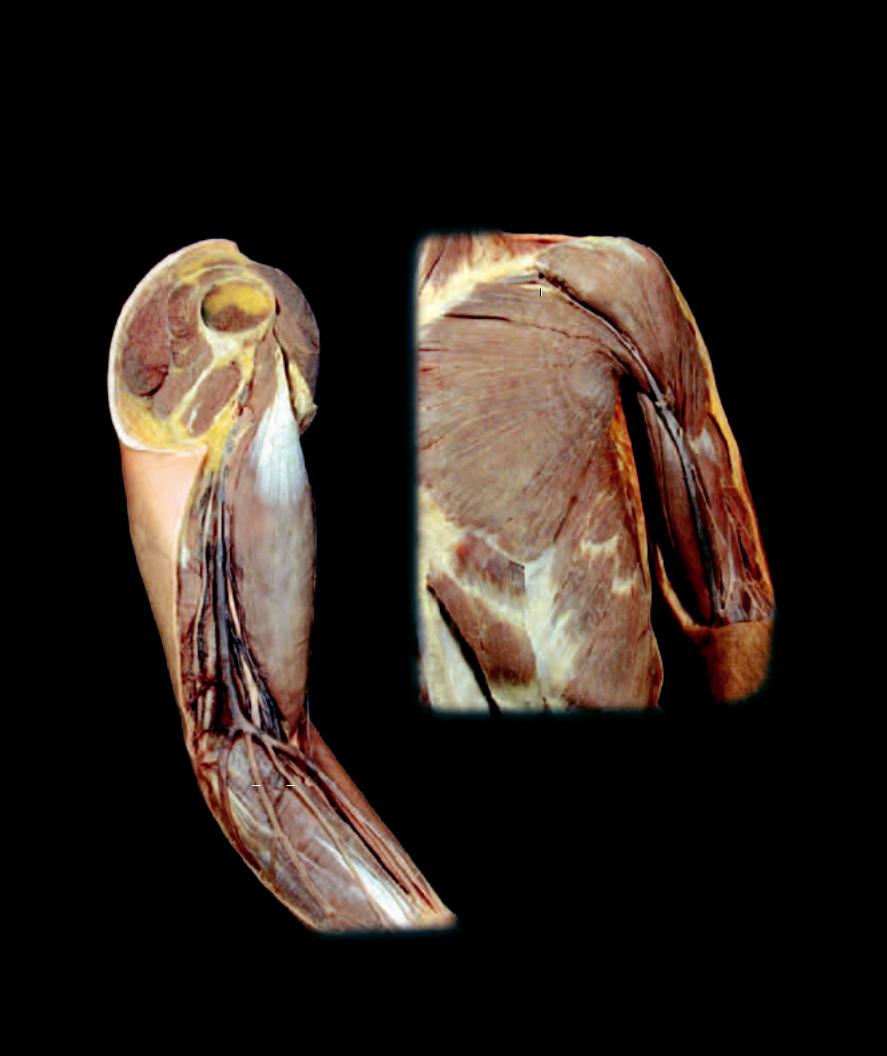
Within the upper limb there are two sets of veins: deep veins that accompany the arteries, and superficial veins that course through the hypodermis without arterial counterparts. The deep veins, running with the arteries of the upper limb, have the same names as their arterial counterparts. These veins are significantly smaller than the arteries they accompany and form vena comitans with anastomotic channels around the arteries. The superficial veins of the upper limb are large and numerous. There are three major superficial veins into which all the other superfi cial veins fl ow; they are the basilic vein, cephalic vein, and median cubital vein. The median cubital vein is a connecting vein between the cephalic vein and the basilic vein. The cephalic and basilic veins eventually pass deep to join the axillary vein at the proximal end of the limb. Most of the venous return from the upper limb passes through the superficial veins.
24
25
24
24
22 |
28 |
9 |
|
|
23 |
22 |
|
26
21
21
22
11
|
10 |
|
|
Dissection of cephalic vein |
|
|
27 |
||||
11 |
Anterior view |
||||
12 |
|
13 |
|
|
9 |
|
|
|
|||
Dissection of superficial vein of upper limb
Medial view of left upper limb
277
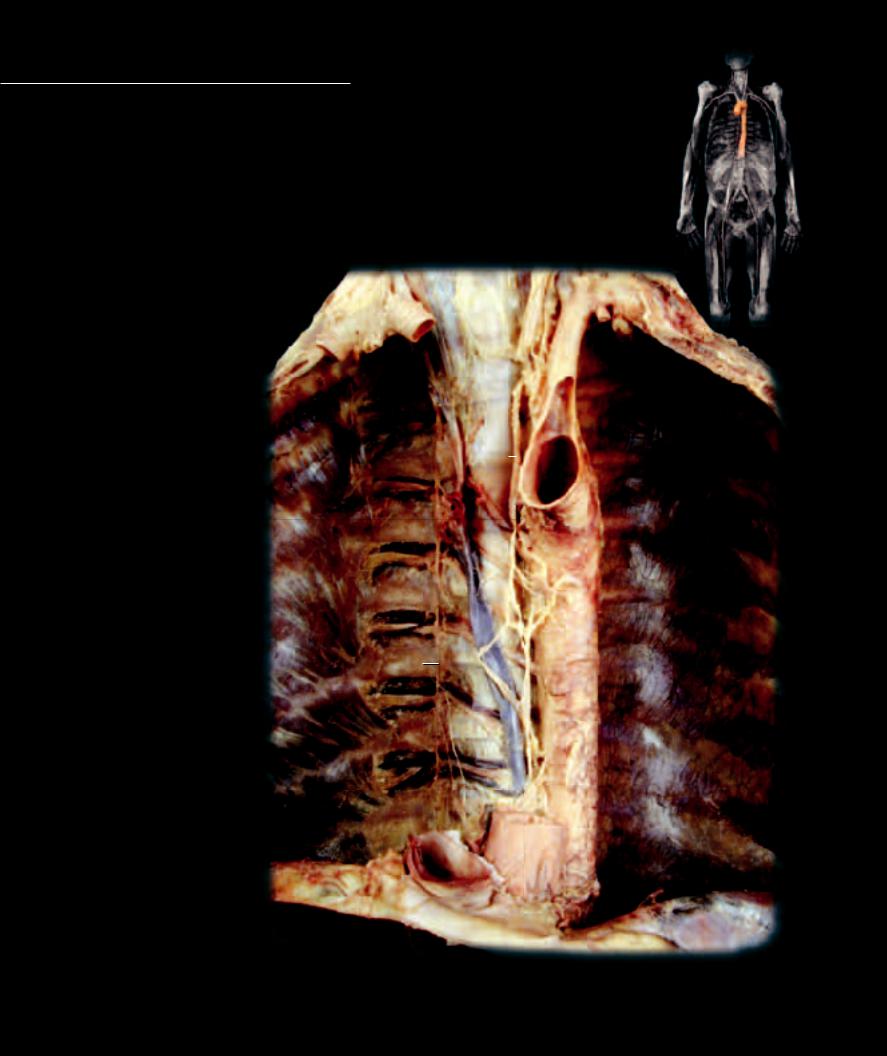
The branches of the aorta that supply the thoracic region can be divided into two principal groups — those that supply the thoracic body wall and those
that supply thoracic viscera. Two arterial supply routes carry blood into the thoracic body wall. Posteriorly the aorta courses vertically down the vertebral column, while anteriorly the internal thoracic arteries arise from the subclavian arteries and course vertically down the inside of the sternum. Between these anterior and posterior supply arteries are interconnecting collateral arteries. These collateral vessels are the anterior intercostal arteries and the posterior intercostal arteries, which supply the tissues of the intercostal spaces and form collateral circuits between the anterior and posterior arterial pathways. All thoracic viscera receive their blood supply from branches of the aorta. The thoracic viscera include the heart, lungs with their associated bronchial tubes, and the esophagus.
1 Aorta
2 Posterior intercostal artery
3 Posterior intercostal vein
4 Azygos vein
5 Hemi-azygos vein
6 Accessory hemi-azygos vein
7 Superior vena cava
8 Brachiocephalic vein
9 Subclavian vein
10Internal jugular vein
11Inferior vena cava
12 Right atrium (cut) |
13 |
13Left subclavian artery
14Left common carotid artery
15Right common carotid artery
16 |
Hepatic vein |
24 |
|
|
|
|
|||
|
|
|
||
17 |
Trachea |
1 |
||
18 |
Diaphragm |
20 |
|
|
19 |
Esophageal hiatus |
2 |
|
|
20 |
Subcostal muscle |
|
|
|
|
|
|
||
21 |
Innermost intercostal muscle |
|
|
|
22 |
Esophagus |
|
|
|
23 |
Sympathetic trunk nerve |
|
|
|
24 |
Thoracic lymphatic duct |
|
|
|
|
|
4 |
|
|
23
3
21
2
22
18 |
11 |
|
Dissection of vessels of posterior thoracic wall
Anterior view
278
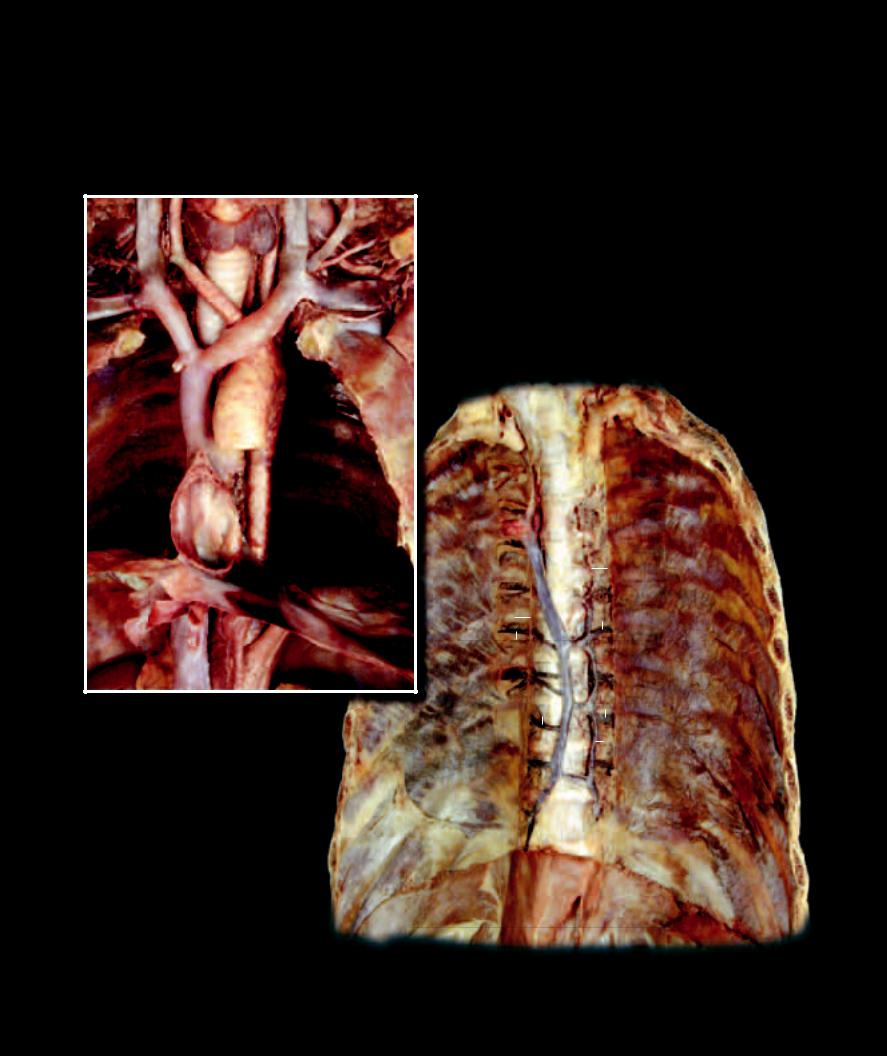
Like the arterial supply to the thoracic wall, the venous drainage returns via both anterior-wall and posterior-wall drainage veins. The veins of the anterior wall have the same names as their arterial counterparts, while the veins of the posterior wall differ in name and structure. Unlike the aorta, which is the posterior-wall supply artery, the superior vena cava and inferior vena cava diverge from the posterior thoracic wall to enter the thoracic cavity and return their contents to the heart. In the absence of vena cavae in the posterior thoracic wall, an azygos system of veins is formed to drain the body wall and the thoracic viscera. These azygos veins communicate with the superior vena cava to return their contents to the heart. With the exception of the azygos veins, the veins are similar to the arteries in name and distribution.
15
10 |
10 |
|
|
|
17 |
|
14 |
9 |
9 |
|
|
|
8 |
|
8 |
71
|
|
20 |
|
|
|
|
|
|
|
|
|
|
|
|
|
|
|
|
|
|
|
|
6 |
16 |
|
23 |
|
|
|
4 |
3 |
|
|||
|
|
|
|
|
|
||||||
|
|
|
|||||||||
19 |
|
|
|
|
|
|
|
|
|
|
|
|
|
|
|
|
|
|
|
|
|
|
|
|
|
|
|
|
|
|
|
|
|
|
|
18 |
|
|
3 |
|
|
|
|
|
|
||
|
|
|
|
|
|
|
|
|
|
|
|
11 |
|
|
|
|
|
|
|
|
|
|
|
Dissection of vena cavae and tributaries |
21 |
|
3 |
3 |
|||||||
|
|
|
|
|
|||||||
|
|
|
|
|
|||||||
Anterior view |
|
|
|
|
|
|
|
|
|
5 |
|
|
|
|
|
|
|
|
|
|
|||
|
|
|
|
|
|
|
|
|
|
||
|
|
|
|
|
|
|
|
|
|||
Dissection of azygos veins
Anterior view
279
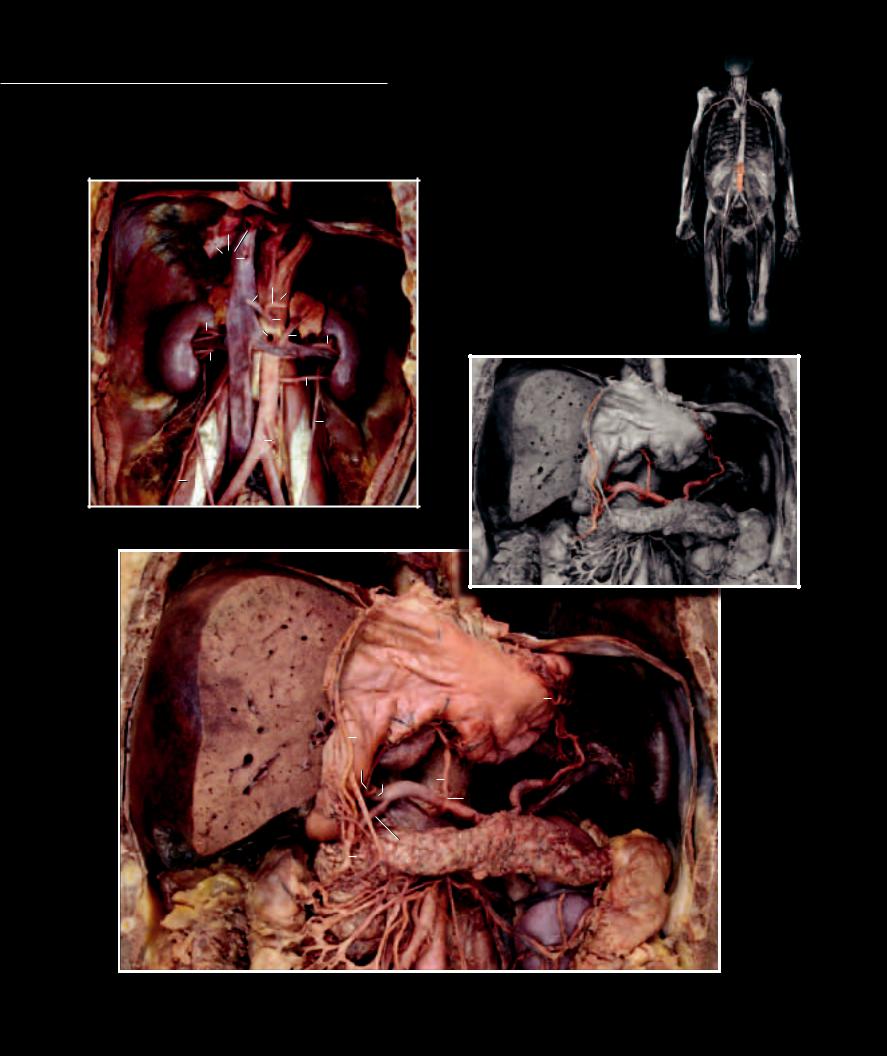
Like the thorax, the abdomen has somatic arteries that supply the abdominal muscle wall and visceral arteries that supply the viscera of the abdominal cavity. These vessels follow the same
pattern observed in the thoracic region; that is, the abdominal body wall has both anterior (epigastric arteries) and posterior (aorta) supply pathways that form interconnecting collateral arteries, while the viscera receive branches from the aorta — celiac artery to the foregut, superior mesenteric artery to the midgut, inferior mesenteric artery to the hindgut, and renal arteries to the kidneys.
46 |
|
|
|
|
|
|
|
|
|
|
|
|
|
|
|
|
|
|
|
|
|
|
|
|
|
|
|
|
|
|
|
|
|
|
|
|
|
|
|
|
|
27 |
|
|
3 |
|
|
|
|
|
|||||
|
|
|
|
|
|
|
|||||||
|
|
|
|
|
|
|
|
|
|
|
|||
4 |
|
|
5 |
|
|
|
|||||||
|
|
|
|
||||||||||
39 |
|
|
|
|
|
39 |
|
|
|||||
23 |
|
|
|
|
|
|
|
||||||
|
|
|
|
|
|
2 |
|
|
|
||||
|
12 |
|
|
|
33 |
23 |
|||||||
|
|
|
|||||||||||
|
|
|
|
|
|
||||||||
35 |
|
|
|
|
|
|
|
|
|
|
|||
|
|
|
|
|
|
|
|
|
|
|
|
||
|
26 |
|
28 |
35 |
|||||||||
|
|
|
|||||||||||
|
|
|
|
|
|||||||||
|
|
|
|
|
|
|
|
|
|
|
|
|
|
23
1
23
47
19
25
34
48
Deep dissection of abdomen showing renal vessels
Anterior view
|
|
|
|
|
|
|
|
|
|
|
|
|
|
|
Branches of celiac artery |
|
|
|
|
|
|
37 |
|
|
|
|
|
|
46 |
||
|
36 |
|
|
|
|
|
|
|
|
|
|
|
|
|
|
|
|
|
|
|
|
|
|
|
|
|
|
|
7 |
|
|
|
|
|
|
|
|
|
|
|
|
|
|
|
|
|
|
|
|
|
|
8 |
|
|
|
|
|
|
|
41 |
|||
|
|
|
|
|
|
|
|
|
|
|
|
|
|||
|
|
|
|
|
|
|
|
|
|
|
|
||||
|
6 |
|
|
|
|
|
|
|
|
|
|
||||
|
9 |
5 |
|
|
|
|
|
3 |
|
|
|
||||
|
|
|
|
|
|
|
|
|
|||||||
|
|
|
|
|
|
4 |
|
|
|
|
2 |
32 |
|||
|
|
|
|
|
|
|
|
|
|
|
|
||||
|
|
|
|
|
|
29 |
|
|
|
|
|
|
|
|
|
|
|
|
|
|
|
|
|
|
|
|
|
|
|
|
|
|
|
|
|
|
11 |
10 |
|
|
|
|
|
40 |
|
|
|
|
|
|
|
|
|
|
|
|
|
|
|
|
|
||
|
|
|
|
|
|
|
|
|
|
|
23 |
|
|
|
|
|
|
|
|
|
|
|
|
|
|
|
|
|
|
|
|
|
|
|
|
|
|
12 |
|
|
|
|
|
|
44 |
||
|
|
|
|
|
|
|
|
|
|
|
31 |
35 |
|
||
|
|
|
|
|
|
|
|
|
|
|
|
|
|
||
43 |
30 |
|
1 |
|
|
|
|
|
|
|
|||||
|
|
|
|
|
|
|
|
|
|||||||
Dissection of abdomen showing celiac branches and supply of foregut viscera
Anterior view, stomach reflected upward
280
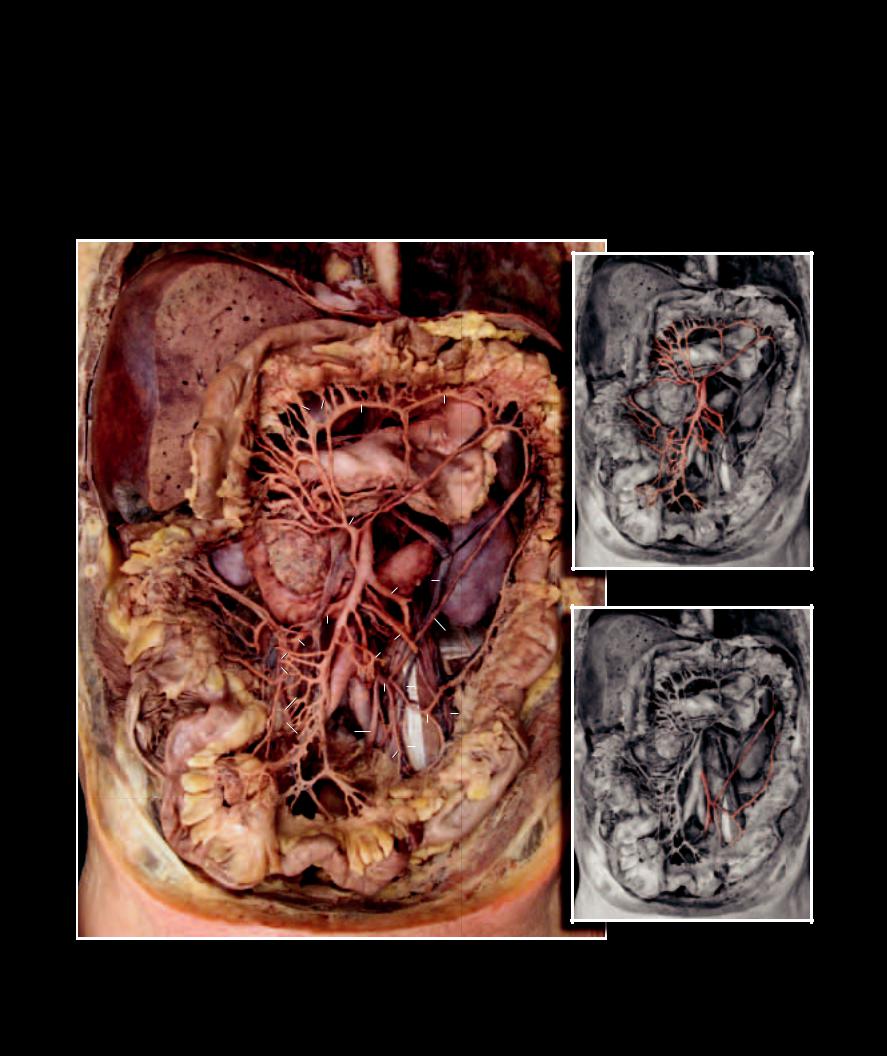
1 |
Aorta |
13 |
Middle colic artery |
25 |
Common iliac artery |
37 |
Stomach |
2 |
Celiac artery |
14 |
Marginal artery |
26 |
Inferior vena cava |
38 |
Transverse colon |
3 |
Splenic artery |
15 |
Right colic artery |
27 |
Hepatic vein |
39 |
Suprarenal gland |
4 |
Common hepatic artery |
16 |
Ileocolic artery |
28 |
Renal vein |
40 |
Pancreas |
5 |
Left gastric artery |
17 |
Jejunal arteries |
29 |
Hepatic portal vein |
41 |
Spleen |
6 |
Right gastric artery |
18 |
Ileal arteries |
30 |
Superior mesenteric vein |
42 |
Duodenum |
7 |
Left gastro-omental artery |
19 |
Inferior mesenteric artery |
31 |
Inferior mesenteric vein |
43 |
Ascending colon |
8 |
Right gastro-omental artery |
20 |
Left colic artery |
32 |
Splenic vein |
44 |
Descending colon |
9 |
Proper hepatic artery |
21 |
Sigmoid artery |
33 |
Suprarenal vein |
45 |
Ileum |
10 |
Gastroduodenal artery |
22 |
Superior rectal artery |
34 |
Testicular vein |
46 |
Diaphragm |
11 |
Superior pancreaticoduodenal artery |
23 |
Renal artery |
35 |
Kidney |
47 |
Ureter |
12 |
Superior mesenteric artery |
24 |
Segmental arteries |
36 |
Liver |
48 |
Psoas major muscle |
46
38
36
|
24 |
|
|
|
|
|
|
|
|
|
|
14 |
|
|
|||
|
|
14 |
|
|
|
|
|
|
|
|
|||||||
|
|
|
|
|
|
|
|
|
|
|
|
|
|
||||
|
|
|
|
|
|
|
|
|
|
|
|
|
|
|
|||
|
|
|
|
|
|
|
|
|
|
|
|
41 |
|||||
|
|
|
|
|
|
|
|
|
|
|
|
37 |
|
||||
|
|
|
13 |
|
|
|
|
|
|
|
|
|
|
|
|
||
35 |
40 |
|
12 |
|
|
|
|
|
35 |
||||||||
|
|
|
|
|
|
|
|
|
|
|
|
||||||
43 |
30 |
|
|
|
|
17 |
|
31 |
|
|
|
|
|||||
|
|
|
|
|
|
|
|
||||||||||
42 |
|
|
|
|
|
|
|
|
|
|
|
|
|
|
|
|
|
|
|
|
|
|
|
|
|
|
|
|
|
|
|
|
|
|
|
|
|
|
|
|
|
|
|
|
|
|
|
|
|
|
|
|
|
|
|
|
|
|
|
|
|
|
|
|
|
|
|
|
|
|
|
|
15 |
|
|
|
|
|
|
|
|
|
20 |
||||||
|
|
|
|
|
|
|
17 |
|
|
|
|||||||
|
15 |
|
|
|
|
|
|
|
|
|
|
|
|
|
|
||
|
|
|
|
|
|
|
|
|
|
|
44 |
||||||
|
16 |
|
|
|
|
|
|
|
|
|
|
||||||
|
25 |
|
|
|
|
|
|
|
|
|
31 |
|
|
|
|
||
|
|
|
|
|
|
|
|
|
|
|
|
|
|
||||
|
|
|
25 |
|
19 |
|
|
|
|
|
|
|
|
34 |
|||
|
18 |
|
|
|
|
|
|
|
|
|
|
|
|
|
|
|
|
|
|
|
|
|
|
|
|
|
|
|
|
|
|
|
|||
|
22 |
|
|
|
|
|
|
|
|
|
20 |
|
|
|
|||
|
|
|
|
|
|
|
|
|
|
||||||||
|
|
|
|
|
|
|
21 |
|
|
|
47 |
|
|
|
|||
|
|
|
|
|
|
|
|
|
|
|
|
||||||
|
|
|
|
|
|
|
|
|
|
|
|
|
|
|
|
||
Superior mesenteric artery
45
Inferior mesenteric artery
Dissection of abdomen showing arterial supply of midgut and hindgut viscera
Anterior view
281
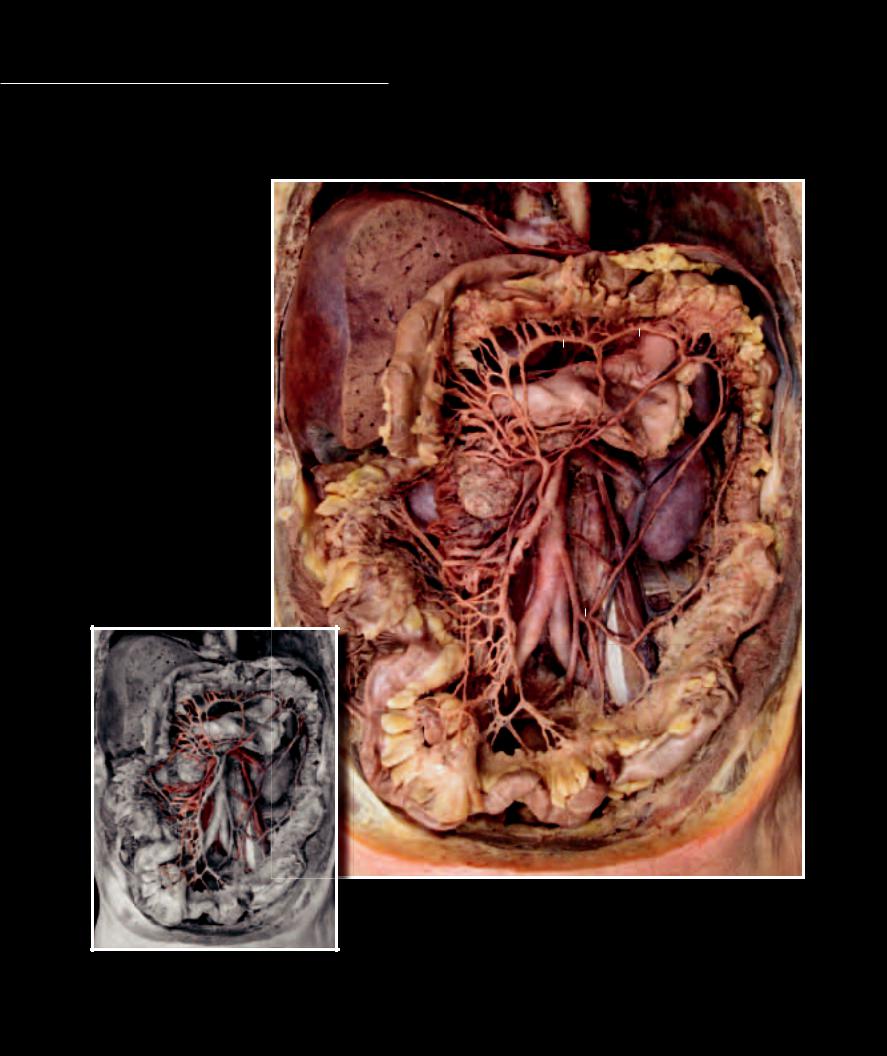
The major difference between the arteries and veins of the abdomen is the fact that all the visceral venous return from the capillaries of the digestive system and spleen pass via the hepatic portal system to the
capillaries of the liver before returning to the heart. Within the liver, both the hepatic artery and hepatic portal vein branch to form a complex network of specialized capillaries called the hepatic sinusoids. The hepatic sinusoids then drain into the hepatic veins to return the blood to the inferior vena cava.
1 |
Inferior vena cava |
|
|
|
2 |
Hepatic portal vein |
|
|
|
3 |
Superior mesenteric vein |
|
|
|
4 |
Right colic vein |
|
|
|
5 |
Inferior mesenteric vein |
|
|
|
6 |
Renal vein |
|
|
|
7 |
Superior mesenteric artery |
|
|
|
8 |
Inferior mesenteric artery |
|
|
|
9 |
Middle colic artery |
|
|
|
10 |
Marginal artery |
|
|
|
11 |
Left colic artery |
|
|
|
12 |
Common iliac artery |
|
|
|
13 |
External iliac artery |
|
|
|
14 |
Internal iliac artery |
|
|
|
|
10 |
|||
|
||||
15 |
Superior gluteal artery |
|
||
10 |
|
|||
|
|
|
||
16Inferior gluteal artery
17Obturator artery
18Internal pudendal artery
19Lateral sacral artery
20Superior vesical artery
21Vaginal artery
22Obliterated umbilical artery
23Uterus
24 |
Bladder |
2 9 |
6 |
25 |
Prostate |
7 |
5 |
26 |
Rectum |
|
28 |
27 |
Stomach |
3 |
|
28 |
Kidney |
|
|
29 |
Upper bands of sacral plexus |
4 |
|
|
|
30Sympathetic trunk
31Inferior vesical artery
32 |
Middle rectal artery |
8 |
|
|
33 |
Obturator nerve |
1 |
|
|
11 |
||||
34 |
Uterine artery |
|||
|
|
|||
|
|
12 |
|
|
|
|
|
||
Dissection of abdomen showing arteries and veins of the intestines
Anterior view
Abdominal veins
282
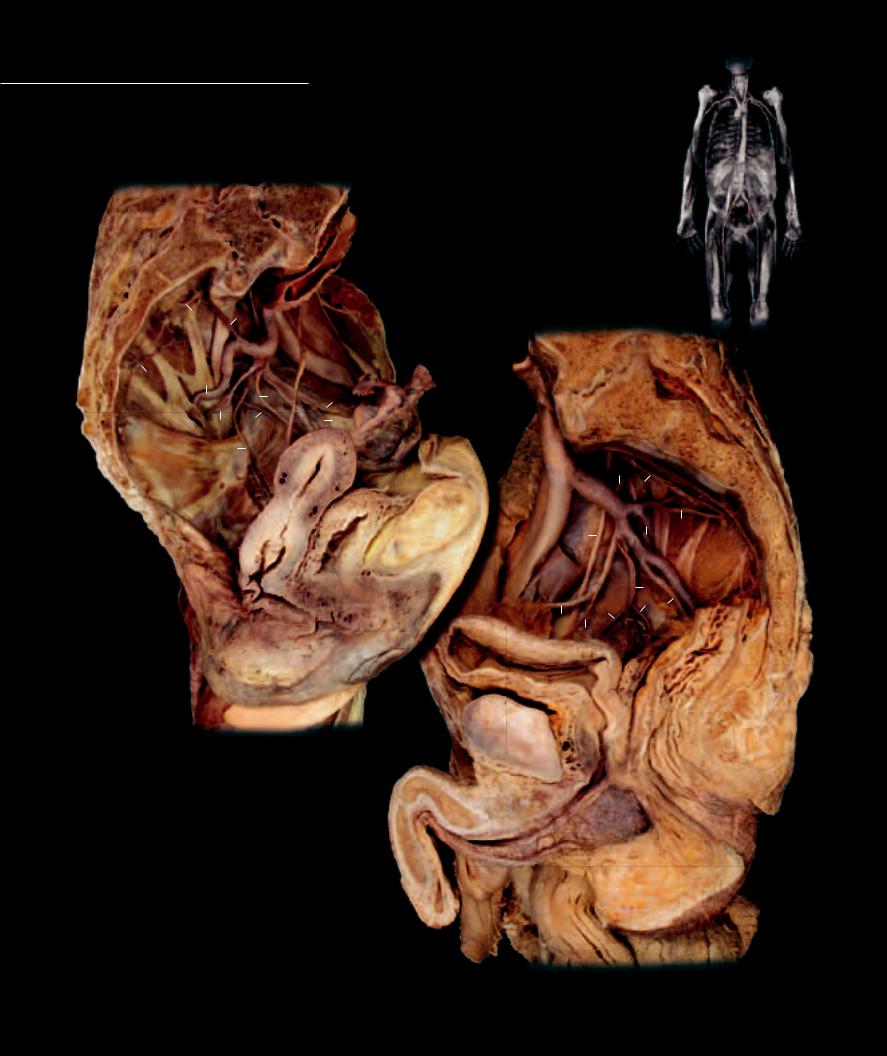
The common iliac arteries, the terminal branches of the aorta, carry all of the blood supply to the lower limbs and pelvis. All pelvic viscera, along with the body wall anatomy
of the pelvis and perineal regions, receive their blood supply from the internal iliac artery. Numerous branches arise from the internal iliac artery to supply the pelvic wall, the perineum, and the gluteal region. Other branches course into the pelvic cavity to supply the viscera. The veins are similar in name and course with the corresponding arteries.
|
|
|
|
|
|
|
|
|
|
12 |
|
|
|
30 |
|
|
|
19 |
|
|
|
|
|
||
|
|
|
|
|
|
|
|
|
|
|
|
|
|
29 |
|
|
|
|
|
|
14 |
|
|
|
|
29 |
16 |
|
|
|
|
|
|
|
13 |
|||
19 |
|
|
|
|
|
|
|
|||||
|
|
|
|
|
|
|
|
|
|
|||
29 |
|
|
|
|
|
|
|
|
34 |
22 |
||
|
|
|
|
|
|
|
|
|||||
|
|
|
|
|
|
|
|
|||||
|
|
|
|
|
|
|
|
|||||
|
|
|
|
|
20 |
|
|
|
|
17 |
||
|
|
|
|
|
|
|
|
|
||||
|
|
|
18 |
|
|
|
|
|||||
|
|
|
|
|
|
|
|
|
|
|
||
|
|
|
21 |
|
|
|
|
|
23 |
|||
|
|
|
|
|
|
|
|
|||||
24
26
Dissection of pelvic arteries of female
Medial view, anterior at left
12 |
|
|
|
|
|
|
|
|
|
|
|
|
|
|
|
|
|
19 |
|
|
|
|
|
||
14 |
|
|
|
|
||||||||
|
|
30 |
|
|
|
|||||||
|
|
|||||||||||
|
|
|
|
|
|
|
|
|||||
|
|
|
|
|
|
|
|
|
|
|||
|
|
|
|
|
|
|
|
|
|
|
||
33 |
|
|
|
|
29 19 |
|||||||
|
|
|
||||||||||
|
|
15 |
|
|||||||||
13 |
|
|
|
|
|
|||||||
|
|
|
|
29 |
||||||||
|
|
|
|
|
||||||||
|
|
|
|
|
16 |
|
||||||
|
|
|
|
|
|
|
|
|
31 |
|
||
|
|
|
|
|
|
|||||||
|
|
17 |
32 |
|
||||||||
|
|
18 |
|
|||||||||
|
|
|||||||||||
22
20
26
24
25
Dissection of pelvic arteries of male
Medial view, anterior at right
283

As in the upper limb, the main arterial pathway into the lower limb consists of a single, major arterial roadway that
gradually tapers as it gives rise to numerous branches on its pathway through the limb. This large arterial roadway begins as the external iliac artery in the pelvis, passes beneath the inguinal ligament to enter the thigh as the femoral artery, passes to the back of the knee to become the popliteal artery, and in the proximal aspect of the leg bifurcates into the anterior tibial and posterior tibial arteries, which course through the leg and into the foot.
1 |
Superior gluteal artery |
10 |
Internal iliac artery |
19 |
Adductor longus muscle |
2 |
Inferior gluteal artery |
11 |
External iliac vein |
20 |
Rectus femoris muscle |
3 |
Internal pudendal artery |
12 |
Common iliac artery |
21 |
Vastus intermedius muscle |
4 |
Femoral artery |
13 |
Aorta |
22 |
Gracilis muscle |
5 |
Deep artery of thigh |
14 |
Gluteus maximus muscle |
23 |
Vastus lateralis muscle |
6 |
Muscular branches of femoral |
15 |
Sacrotuberous ligament |
24 |
Vastus medialis muscle |
7 |
Femoral vein |
16 |
Piriformis muscle |
25 |
Fascia lata |
8 |
Great saphenous vein |
17 |
Spermatic cord (cut) |
26 |
Sartorius muscle |
9 |
External iliac artery |
18 |
Penis (cut) |
27 |
Iliacus muscle |
14
1
16
14
2
15
3
22
Dissection of gluteal region showing gluteal arteries and nerves
Posterior view
284
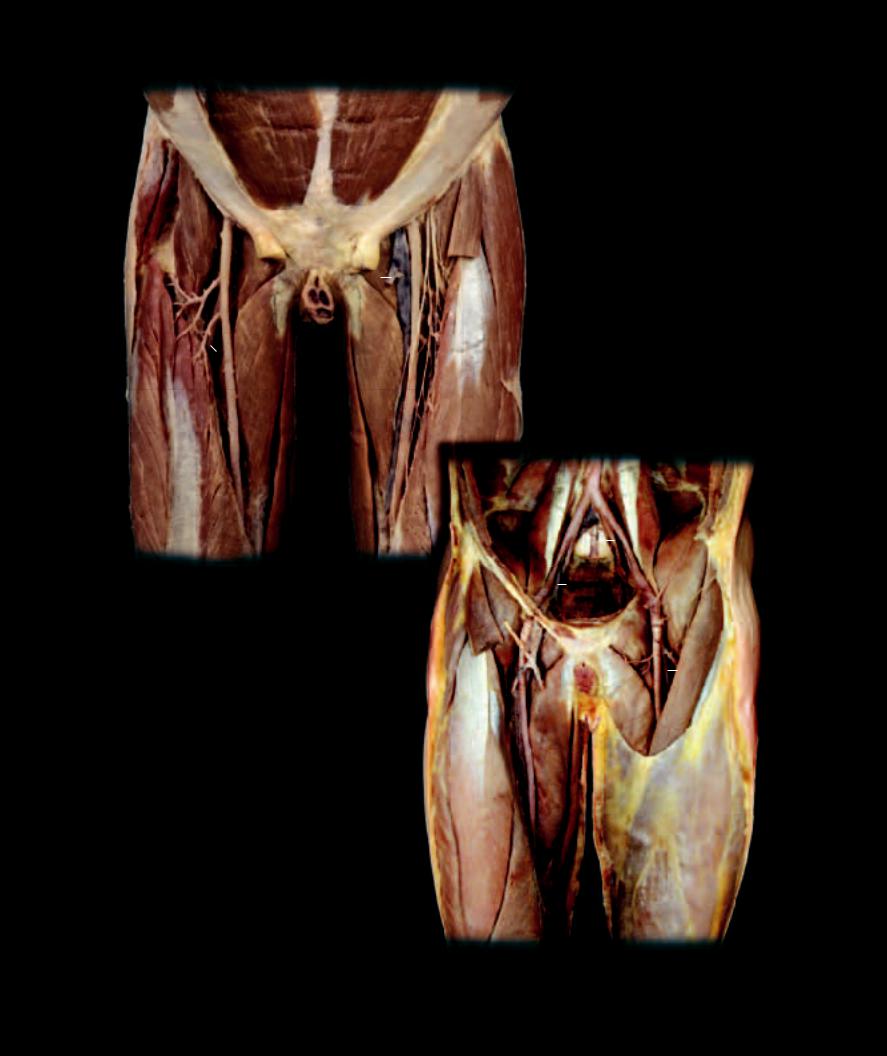
27
|
26 |
||
|
17 |
|
|
|
4 |
|
|
|
8 |
|
|
|
|
|
|
6 |
7 |
||
18 |
|
|
|
6 |
|
|
|
5 |
19 |
|
|
|
20 |
23 |
22 |
|
|
|
|
13 |
|
|
|
|
|
|
|
|
|
|
|
|
|
||
|
|
|
|
|
|
|
|
|
|
|
|
21 |
|
|
12 |
|
|
|
|
|
|
|
24 |
27 |
|
|
|
10 |
|
|
|
|
|
|
|
|
|
|
|
|
|||
|
|
|
|
|
|
9 |
|
|
||
Dissection of femoral vessels in femoral triangle |
|
|
|
11 |
|
|
|
|
|
|
|
|
|
|
|
|
|
|
|||
|
Anterior view |
27 |
|
|
|
|
|
|
|
|
|
|
26 |
|
|
|
|
|
|
26 |
|
|
|
|
7 |
|
|
|
|
|
||
|
|
|
|
|
|
|
|
|
|
|
|
|
|
8 |
18 |
4 |
|
5 |
|||
|
|
|
|
|||||||
|
|
|
|
|
|
|
|
|||
|
|
|
|
|
|
|
|
|
|
|
|
|
|
4 |
|
|
|
|
|
|
|
|
|
|
19 |
|
|
|
|
|
|
|
20 |
25 |
22
23
24
Dissection of vessels of inferior limb
Anterior view
285
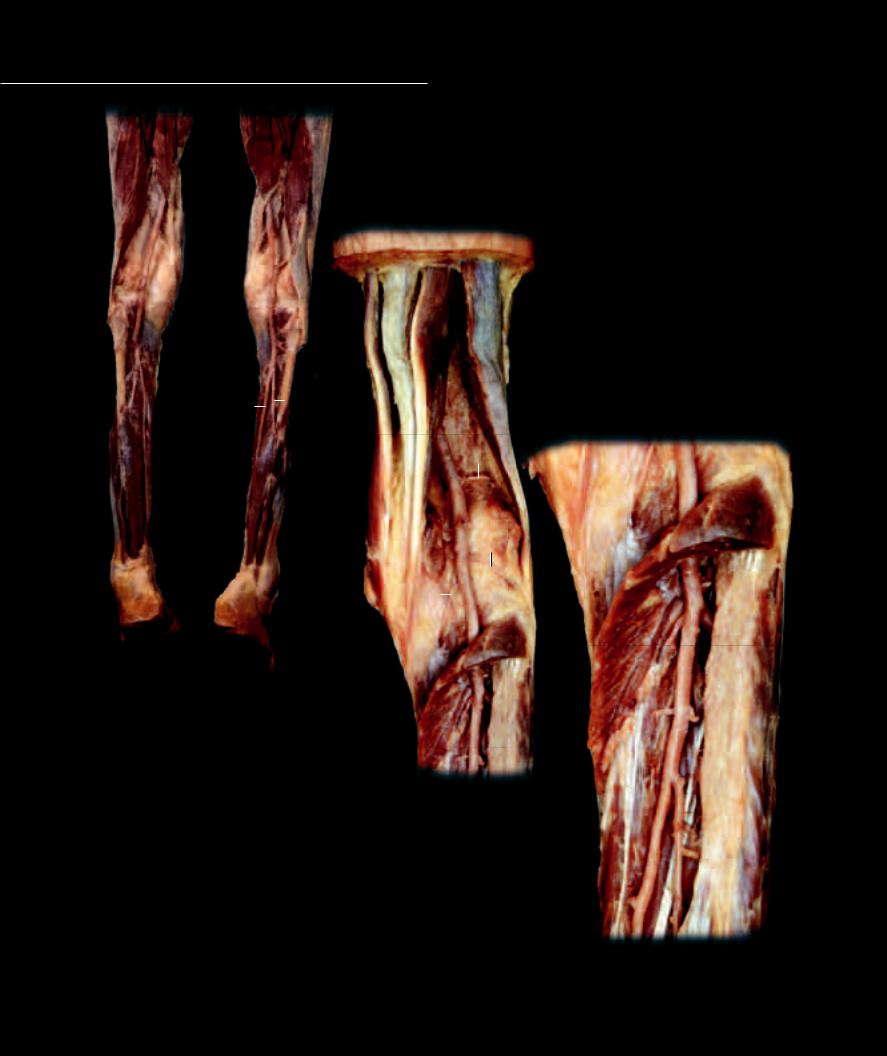
Inferior Limb Vessels
|
|
|
|
|
|
|
1 |
Popliteal artery |
|
|
|
|
|
|
|
2 |
Anterior tibial artery |
|
|
|
|
|
|
|
3 |
Posterior tibial artery |
|
|
|
|
|
|
|
4 |
Fibular artery |
|
|
|
|
|
|
|
5 |
Superior lateral genicular artery |
|
|
|
|
|
|
|
6 |
Inferior lateral genicular artery |
|
|
|
|
|
|
|
7 |
Inferior medial genicular artery |
|
|
|
|
|
|
|
8 |
Femoral vein |
23 |
|
|
|
|
|
|
9 |
Great saphenous vein |
|
|
|
|
|
|
10 |
Femoral artery |
|
|
|
|
|
|
|
|
||
|
|
|
|
|
|
|
11 |
Superficial epigastric artery |
|
|
|
|
|
|
|
12 |
Superficial epigastric vein |
|
1 |
|
|
|
13 |
External pudendal vein |
||
|
|
|
|
14 |
Superficial circumflex iliac vein |
|||
|
|
|
|
|
|
|
||
|
|
|
|
|
|
|
15 |
Superficial circumflex iliac artery |
|
|
|
|
|
|
|
16 |
Femoral nerve |
|
|
|
|
|
|
|
17 |
Soleus muscle |
|
18 |
|
|
18 |
Popliteus muscle |
|||
|
|
|
19 |
Subcutaneous layer |
||||
|
24 |
|
|
20 |
Fascia lata |
|||
|
|
|
|
|
|
|
||
|
|
|
|
|
|
|
21 |
Sartorius muscle |
|
|
|
|
|
|
|
22 |
Adductor longus muscle |
|
|
|
|
|
23 |
23 |
Biceps femoris muscle |
|
|
|
|
|
|
24 |
Semitendinosus muscle |
||
3 |
|
|
4 |
5 |
25 |
Scrotum |
||
|
||||||||
|
|
|
|
|
|
|||
|
|
|
|
|
|
|
||
|
|
|
|
|
|
|
|
1 |
|
|
|
|
|
|
|
|
|
|
|
|
|
|
|
|
|
|
|
|
|
|
|
|
|
|
18 |
|
1 |
6 |
|
|
||||
1
7 |
|
17 |
|
2
18 17
Dissection of popliteal and crural arteries
Posterior view
3
Dissection of popliteal region revealing arteries
Posterior view
3
4
Dissection of proximal crus revealing arteries
Posterior view
286

Similar to the veins of the upper limb, the venous pathways in the lower limb consist of both deep veins that accompany the arteries, and superficial veins that course through the hypodermis. In the foot and leg, the deep veins form vena comitans with their arterial counterparts; however, the more proximal popliteal and femoral veins are large single vessels accompanying their associated arteries. Two major superfi cial venous channels receive numerous tributaries from smaller superfi cial veins throughout the lower limb. These major superficial veins are the small saphenous vein and the great saphenous vein. Unlike the upper limb, the majority of venous blood fl ow through the lower limb passes via the deep veins. Anastomosing veins between the saphenous veins and the deep veins have one-way valves. The valves direct blood fl ow to the deep veins where contractions of surrounding skeletal muscles facilitate movement of the blood toward the heart.
15
14 10 8
16
 13
13
22
21 9
|
15 |
11 |
||
|
21 |
|
|
|
|
|
|
||
20 |
14 |
12 |
||
10 |
||||
|
||||
|
16 |
8 |
||
|
|
|
||
20
13
9
25
19 |
22 |
Dissection of femoral vein and tributaries in femoral triangle
Anterior view
Dissection of great saphenous vein
Anteromedial view
287
